JVC KENWOOD 39632 GPS NAVIGATION SYSTEM User Manual DNX9980HD K English indd
JVC KENWOOD Corporation GPS NAVIGATION SYSTEM DNX9980HD K English indd
Contents
- 1. User's Manual-1
- 2. User's Manual-2
- 3. User's Manual-3
User's Manual-2
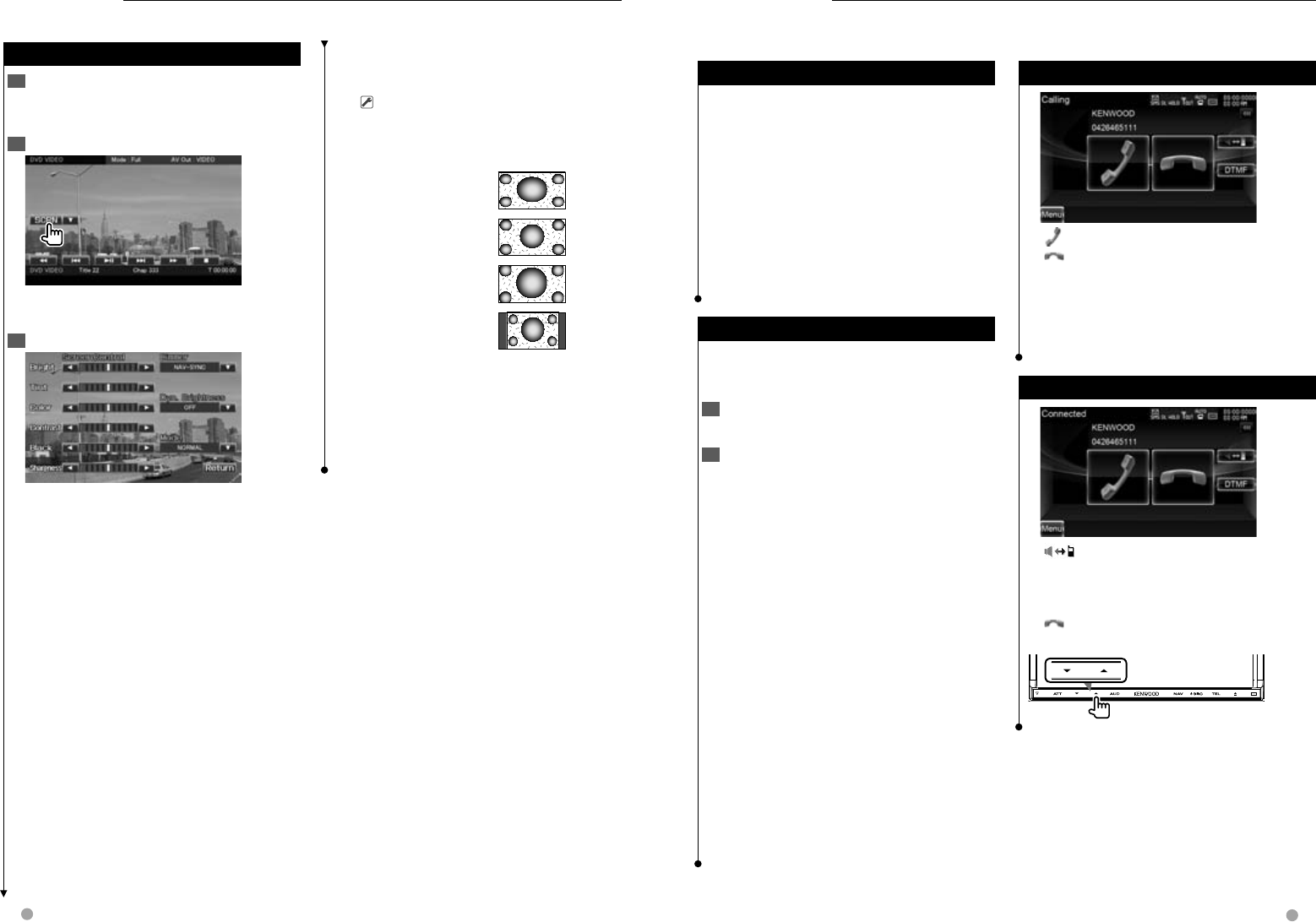
52 DNX9980HD English 53
Next page 3
Hands Free Unit Control
Before Use
Before Use
• For details on the Bluetooth cell-phone with the hands-
free function, see <About the Cell-Phone> (page 8).
• You need to register your cell-phone before using
it with this unit. For more details, see <Registering
Bluetooth Unit> (page 60).
• If you have registered two or more cell-phones, you
need to select one of them. For more details, see
<Bluetooth Unit Connection> (page 62).
• To use the Phone Book, it must be downloaded to this
unit in advance. For details, see <Downloading the
Phonebook> (page 53).
• Sound output speaker can be set. See <Bluetooth
Hands-Free/Audio Output Setup> (page 62).
Downloading the Phonebook
Downloading the Phonebook
Downloads the phonebook data from the
cell-phone to this unit so that you can use the
Phonebook of this unit.
1 By operating the cell-phone, send the
phonebook data to this unit
2 By operating the cell-phone, start the hands-
free connection
⁄
• For the cell-phones which support auto-download of
phonebook:
If the phonebook is not downloaded automatically
for some reasons, follow the procedure above to
download manually.
• For how to operate the cell-phone, refer to the
Instruction Manual that comes with your cell-phone.
• Up to 1000 phone numbers can be registered for each
registered cell-phone.
• Up to 32 digits can be registered for each phone
number along with up to 50* characters representing
a name.
(* 50: Number of alphabetical characters. Fewer
characters can be input depending on the type of
characters.)
• Depending on the type of your cell-phone, the
following restrictions are placed:
- The phonebook data cannot be downloaded
normally.
- Characters in the Phonebook are garbled.
• To cancel downloading of the phonebook data,
operate the cell-phone.
Various functions can be used in the Hands Free control mode.
Receiving a Call
Receiving a Call
[] Answering a Phone Call
[] Rejecting an Incoming Call
⁄
• While monitoring the camera view, this screen is not
displayed even if a call comes in. To display this screen,
press the [TEL] button or return the shift knob of car to
the drive position.
During a Call
During a Call
[] Switches the voice output between
phone and speaker.
[DTMF] Outputs dial tone. See <Controlling
Tone-based Services> (page 56).
[] Disconnecting a call
Adjusting the Voice Volume during a Call
Screen Control
Screen Control
Screen Control
1 Display the Easy Control Screen
See <Operation on the Playback Screen of Visual
Sources> (page 17).
2 Display the Screen Control screen
When the navigation screen is displayed, press the
[TEL] button for 1 second or more.
3 Adjust the picture quality
[Bright] Brightness Control
[Tint] Tint Control
Displayed for an NTSC system image on Video,
iPod, TV or Camera View.
[Color] Color Control
Displayed on Video, iPod, TV or Camera View
screen only.
[Contrast] Contrast Control
[Black] Black Level Adjustment
[Sharpness] Sharpness control
Displayed on Video, iPod, USB, TV or Camera
View screen only.
[Dimmer] Dimmer Mode Setup
"ON": The display dims.
"OFF": The display doesn’t dim.
"SYNC": Turning the Dimmer function On or Off
when the vehicle light control switch is turned
On or Off.
"NAV-SYNC": Turning the Dimmer function On
or Off according to the Navigation Day/Night
display setting.
[Dyn.Brightness] (Dynamic Brightness) The
function compensates for Over Exposure and
Under Exposure creating a clearer picture.
( "OFF")
"OFF"/ "1"/ "2"
[Mode] Selects a screen mode.
You can select any of the following screen mode.
"Full": Full picture mode
"Just": Justify picture
mode
"Zoom": Zoom picture
mode
"Normal": Normal
picture mode
⁄
• The Screen Control screen is displayed only when you
have applied the parking brake.
• The picture quality can be set for each source.
• You can set image quality of screens such as menu
from <Screen Control> (page 80).
Setting the monitor screen.
DNX9980HD_K_English.indd 52-53 10/11/04 18:23
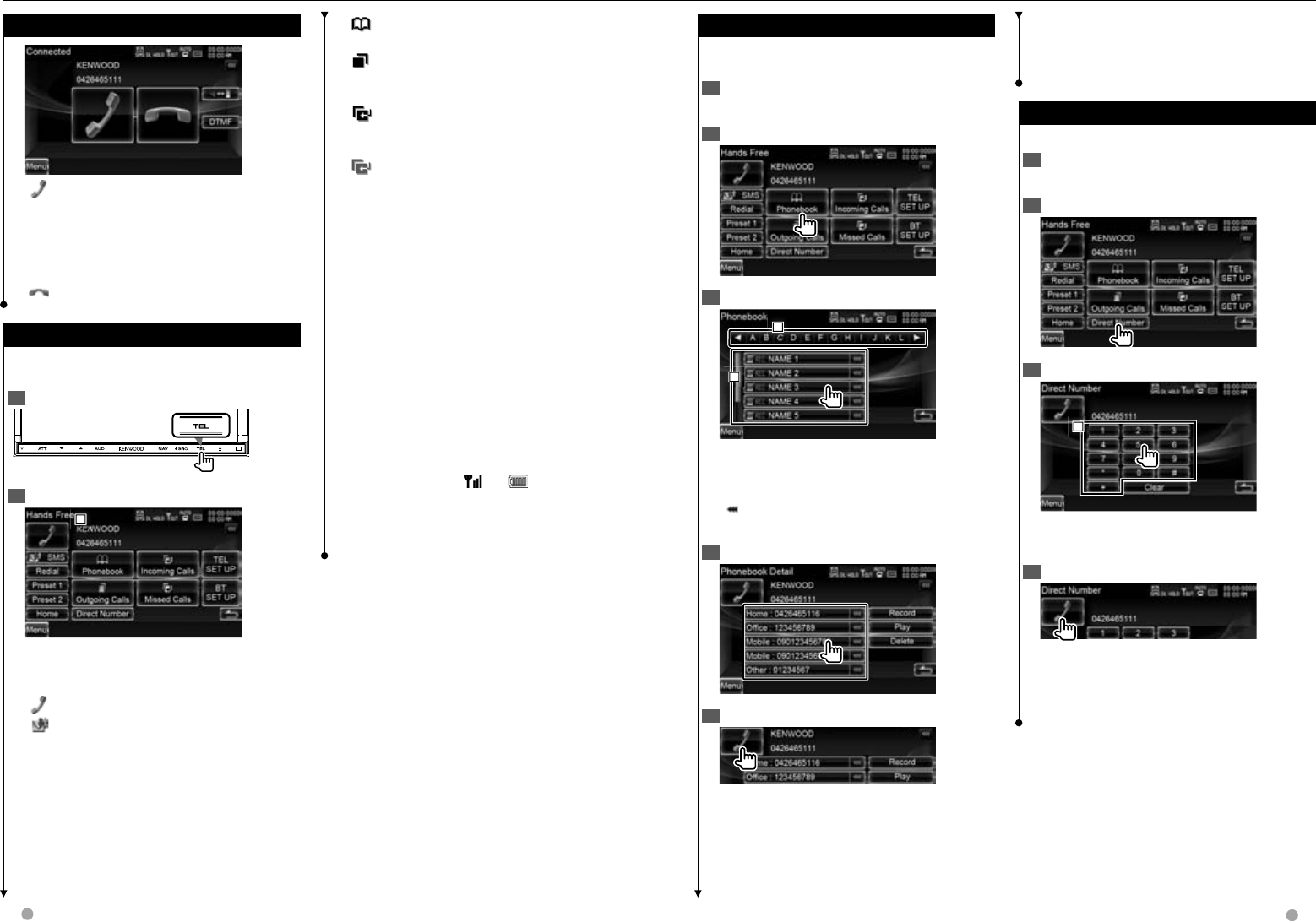
54 DNX9980HD English 55
Next page 3
Calling by Phonebook
Calling by Phonebook
You can call a person using his/her phone number
that you have registered in the Phonebook.
1 Display the Hands-Free Control screen
See <Making a Call> (page 54).
2 Display the Phonebook screen
3 Select the name to call
1
1
1
2
2
2
1 Phonebook data list.
2 Displays the Phonebook name beginning with
the character you have touched.
[] When the text is longer, the text display is
scrolled by touching it.
4 Select the phone number to call
5 Make a call
⁄
• To use the Phonebook, it must have been downloaded
from the cell-phone. For more details, see the
instruction manual of your cell-phone.
• Characters with no corresponding name will not be
displayed.
• During search, a non-accent character such as "u" is
searched for instead of an accent character such as "ü".
Calling by Entering a Phone Number
Calling by Entering a Phone Number
Makes a call by entering a phone number.
1 Display the Hands-Free Control screen
See <Making a Call> (page 54).
2 Display the number input screen
3 Enter a phone number
1
1
1
1 Calls the entered phone number.
[Clear] Clears the number.
4 Make a call
You can start talking when the recipient responds.
⁄
• You can input up to 32 digits.
• This function is unavailable while driving.
Hands Free Unit Control
[ Phonebook] Displays the Phonebook
Search. See <Calling by Phonebook> (page 55).
[ Outgoing Calls] Displays the Outgoing
Calls screen. See <Making a Call Using Call
Records> (page 56).
[ Incoming Calls] Displays the Incoming
Calls screen. See <Making a Call Using Call
Records> (page 56).
[ Missed Calls] Displays the Missed Calls
screen. See <Making a Call Using Call Records>
(page 56).
[Direct Number] Displays the Dialing Display
screen. See <Calling by Entering a Phone
Number> (page 55).
[BT SETUP] Displays the Bluetooth SETUP screen.
See <Registering Bluetooth Unit> (page 60).
[TEL SETUP] Displays the Hands Free Setup
screen. See <Setting Up the Hands-Free Phone>
(page 57).
⁄
• While your car is moving, some functions are disabled
for safety reasons. The buttons associated with the
disabled functions become ineffective if pressed.
• When the Hands-Free Control screen appears, the
name of the connected cell-phone is displayed for 5
seconds.
• The status icons such as and displayed on the
control unit may discord from those displayed on the
cell-phone.
• Setting the cell-phone in the private mode can disable
the hands-free function.
Call Waiting
Call Waiting
[] • Answers another incoming call with the
current call suspended.
• Switching between the current call and
waiting call
Each touch of this button switches the
calling party.
[] Terminates the current call.
Making a Call
Making a Call
Displaying the control screen and using various
functions.
1 Display the Hands-Free Control screen
2 Select a dialing method
1
1
1
1 Calls the displayed phone number. If you have
registered a phone number in the Phonebook,
the person's name is displayed.
[] Calls the displayed phone number.
[SMS] Displays the SMS Select screen. See
<SMS (Short Message Service)> (page 58).
[Redial] Displays the previously called phone
number.
[Preset1], [Preset2], [Home]
Calls the preset phone number.
For information on how to preset a phone
number, see <Phone Number Preset> (page 58).
DNX9980HD_K_English.indd 54-55 10/11/04 18:23
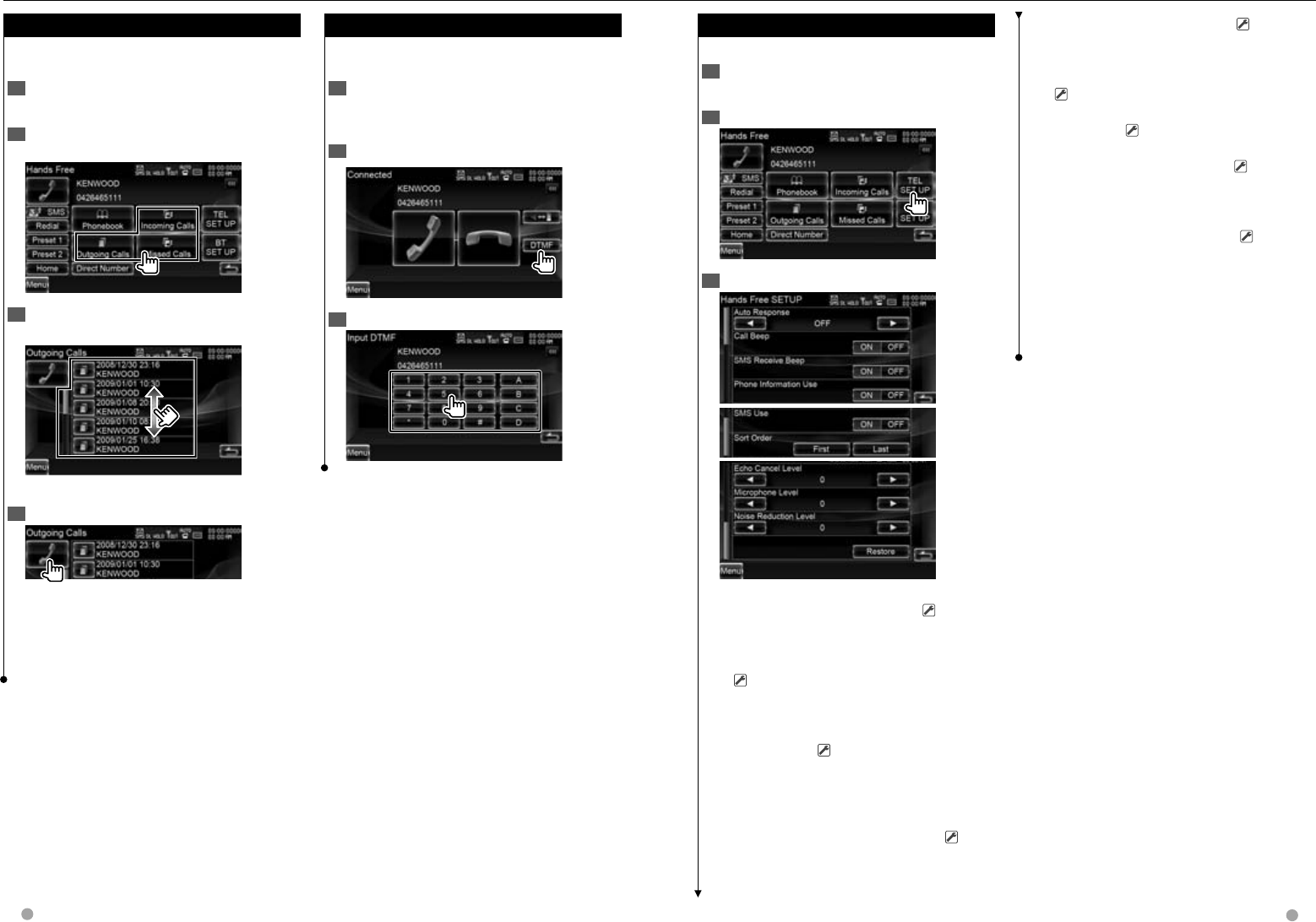
56 DNX9980HD English 57
Next page 3
Setting Up the Hands-Free Phone
Setting Up the Hands-Free Phone
The Hands-Free system can be set as follows.
1 Display the Hands-Free Control screen
See <Making a Call> (page 54).
2 Display the Hands Free Setup screen
3 Set each item
[Auto Response] Sets an automatic response
time to pick-up an incoming calln. ( "OFF")
"OFF": This function can not use.
"0-99": Sets to calling ring time (second).
[Call Beep] Sets the beep of the incoming call.
( "ON")
"ON": Beep is heard.
"OFF": Beep is canceled.
[SMS Receive Beep] Sets the beep of the
incoming SMS. ( "ON")
"ON": Beep is heard.
"OFF": Beep is canceled.
[Phone Information Use] Sets whether to
use cell-phone phonebook, outgoing calls list,
incoming calls list and missed calls list. ( "ON")
"ON": Yes.
"OFF": No.
[SMS Use] Sets the SMS function. ( "ON")
"ON": Use SMS function.
"OFF": SMS not available.
[Sort Order] Sorts the names in the phonebook.
( "First")
[Echo Cancel Level] Adjust the level of echo
cancellation. ( "15")
[Microphone Level] Adjusts the sensitivity of the
microphone for a telephone call. ( "2")
[Noise Reduction Level] Reduce the noises
generated by surrounding environment without
changing the microphone volume. Adjust the
voice of caller when it is not clear. ( "15")
[Restore] Restores the Hands Free SETUP value
to the initial value.
⁄
• Either the time interval for automatic answer set on
this unit or the time interval set on the cell-phone,
whichever is shorter, takes effect.
Hands Free Unit Control
Controlling Tone-based Services
Controlling Tone-based Services
Uses tone base service using DTMF (Dual Tone
Multi Frequency).
1 Display the Talking screen
See <Calling by Entering a Phone Number> (page
55).
2 Display the DTMF input screen
3 You can send tones during a call
Making a Call Using Call Records
Making a Call Using Call Records
Calls by selecting a phone number from the
outgoing, incoming, or missed calls list.
1 Display the Hands-Free Control screen
See <Making a Call> (page 54).
2 Display the Outgoing Calls, Incoming Calls,
or Missed Calls screen
3 Select from calls list
Example : Outgoing Calls screen
Calls the selected phone number.
4 Make a call
⁄
• The Outgoing Calls list screen, Incoming Calls list,
or Missed Calls list screen shows the list of the calls
originated from or received at this unit. They are not
the ones stored in the cell-phone memory.
DNX9980HD_K_English.indd 56-57 10/11/04 18:23
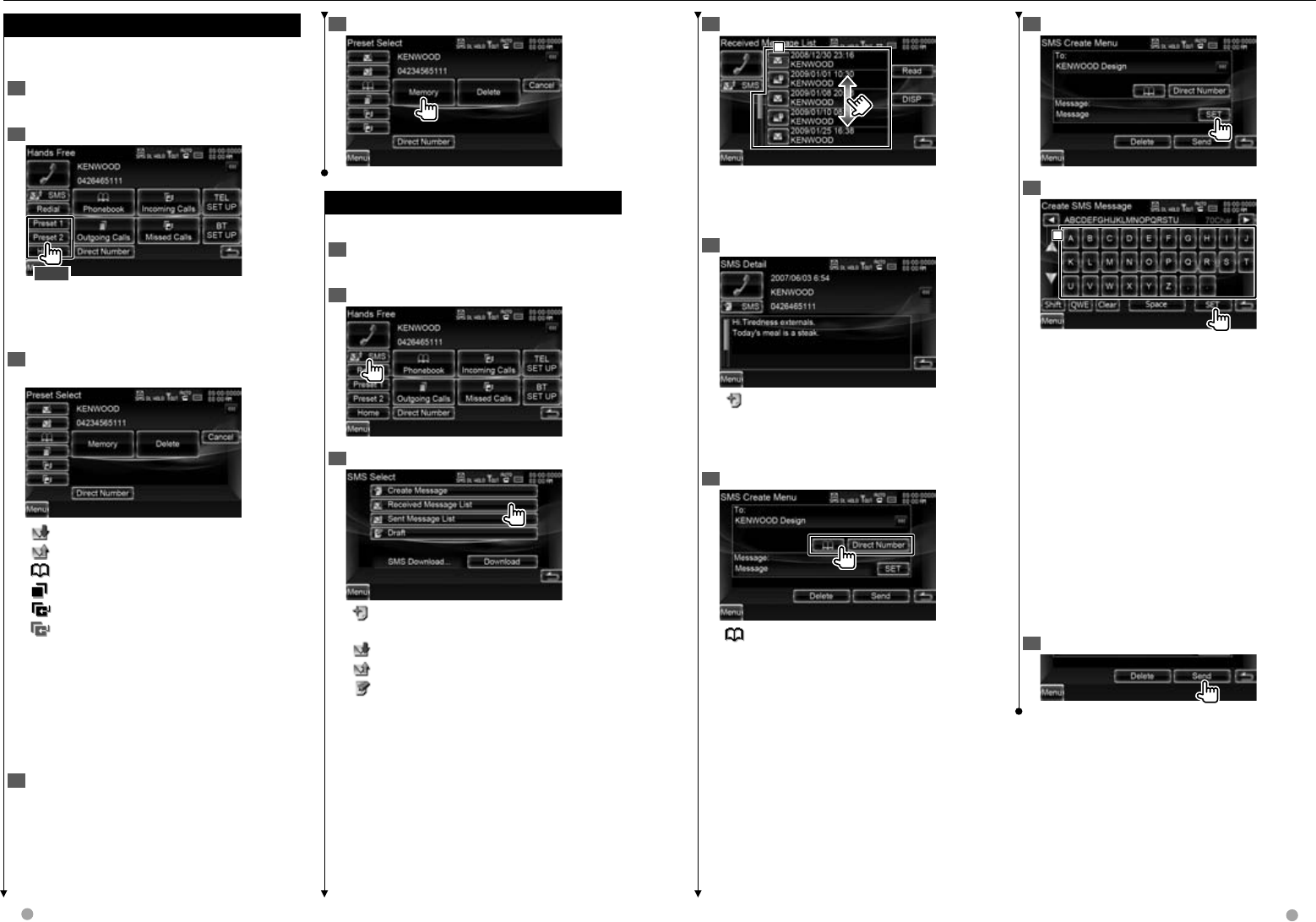
58 DNX9980HD English 59
4 Select a message to display
1
1
1
1 Calls the number in the selected message.
[DISP] Displays the selected message.
[Read] Reads out the selected message.
5 SMS Message screen
[SMS] Creates a new message for the
selected message.
Create a message
1 Input the destination
[] Select a destination from the phonebook.
[Direct Number] Enter the phone number.
[SET] Display the Create SMS Message screen.
[Send] Sends the message.
[Delete] Deletes the Draft message.
Touching the screen displays a confirmation
message. Touch [Yes]. To cancel clearing, touch
[No].
⁄
• This is displayed only when the Draft message is being
edited.
2 Display the Create SMS Message screen
3 Create a message
1
1
1
1 Enters characters.
[2], [3] Moves the cursor.
[5], [∞] Switches between key layouts.
[Shift] Toggles between uppercase and
lowercase.
[qwe]/ [abc]/ [ALT] Sets the key layout of the
character buttons.
abc : Alphabetical key layout.
qwe : Qwerty key layout.
ALT : Alternate key
[Clear] Erases the entered character.
If touched more than 2 seconds, all the input
characters are erased.
[Space] Enters a space.
[SET] Determines the message and returns to the
SMS Create Menu screen.
4 Send the message
Hands Free Unit Control
Phone Number Preset
Phone Number Preset
Registers frequently used phone number to Hands
Free control screen preset button.
1 Display the Hands-Free Control screen
See <Making a Call> (page 54).
2 Select the Preset number to register
2 sec.
⁄
• If no Preset number is registered, pressing this button
momentarily moves to the step 3.
3 Select the search destination of the number
to register
[] Registers from SMS received message list.
[] Registers from SMS sent message list.
[] Registers from Phonebook.
[] Registers from outgoing calls list.
[] Registers from incoming calls list.
[] Registers from missed calls list.
[Direct Number] Registers by entering phone
numbers.
[Memory] Registers the currently displayed
phone number.
[Delete] Deletes the currently displayed phone
number. Touch to display the confirmation
screen. Touch [Yes] to delete or [No] to cancel.
4 Search phone number to register with each
function
5 Register phone number
SMS (Short Message Service)
SMS (Short Message Service)
Uses SMS function.
1 Display the Hands-Free Control screen
See <Making a Call> (page 54).
2 Display the SMS Select screen
3 Select a function
[] Displays the SMS Create Menu screen. See
<Create a message>.
[] Displays received message list.
[] Displays sent message list.
[] Displays the SMS Create Menu screen.
See <Create a message>. The button will be
active when any message has been created after
power-on.
[Download] Retrieves SMS messages from the
cell-phone.
DNX9980HD_K_English.indd 58-59 10/11/04 18:23
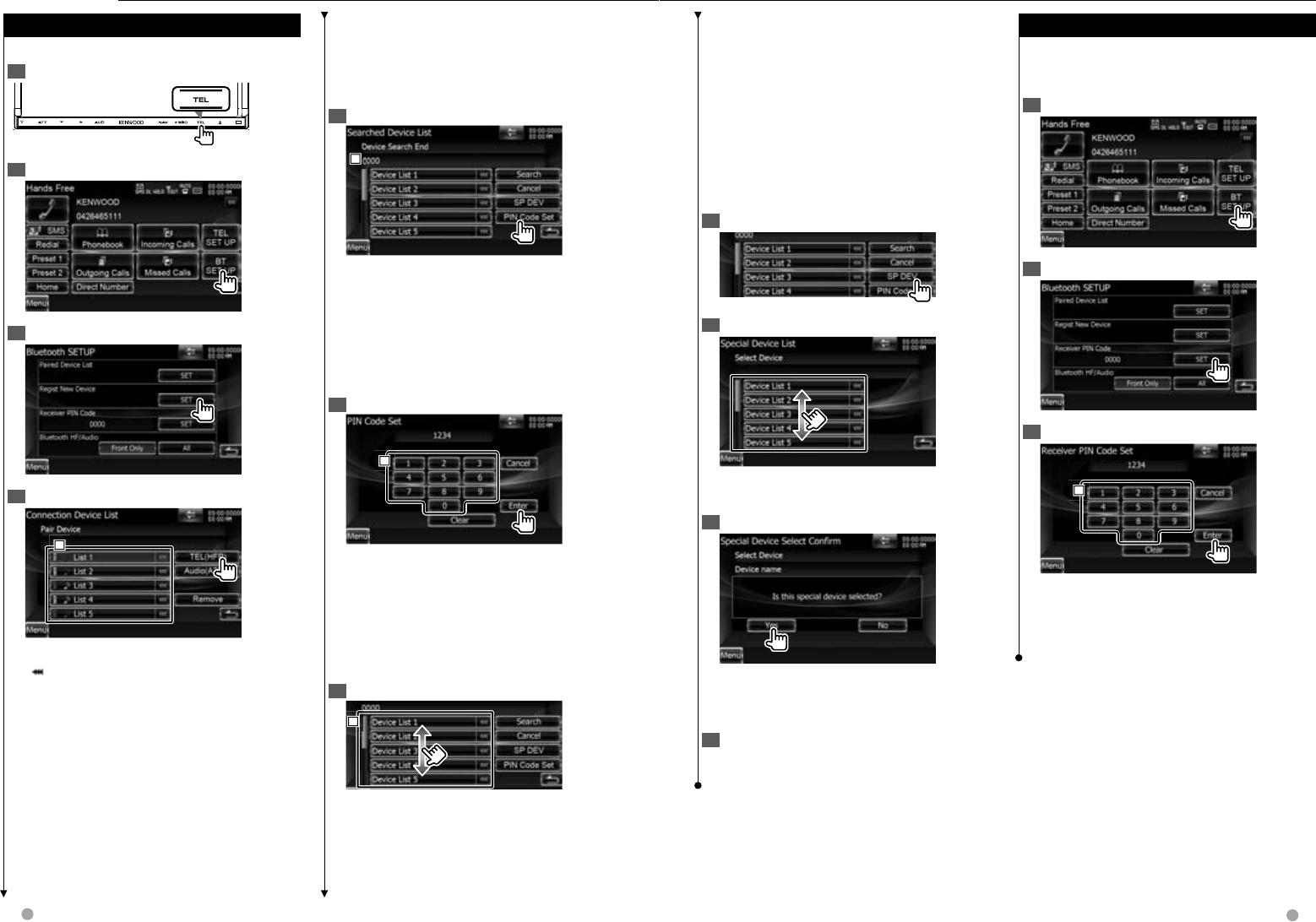
60 DNX9980HD English 61
Next page 3
Bluetooth Setup
Registering Bluetooth Unit
Registering Bluetooth Unit
Registers the Bluetooth unit to be connected.
1 Display the Hands-Free Control screen
2 Display the Bluetooth Setup screen
3 Display the Connect Device List screen
4 Search for a Bluetooth unit
1
1
1
1 Displays the registered Bluetooth units.
[] When the text is longer, the text display is
scrolled by touching it.
[TEL (HFP)] Connects/disconnects cell-phone to
use for Hands Free.
[Audio (A2DP)] Connects/disconnects Audio
player to use for Bluetooth Audio.
[Remove] Deletes registration (pairing).
Touching the screen displays a confirmation
message. Touch [Yes]. To cancel clearing, touch
[No].
⁄
• A new device cannot be registered if there are 5
registered Bluetooth units. Delete unnecessary
registration. See <Bluetooth Unit Connection> (page
62).
5 Display the PIN Code Set screen
1
1
1
1 Display the PIN Code.
[Search] Searches for a Bluetooth unit.
[Cancel] Cancels searching of Bluetooth unit.
[SP DEV] Registers a Bluetooth unit that cannot
be registered by normal register (pairing)
operation.
[PIN Code Set] Display the PIN Code Set screen.
6 Enter PIN code
1
1
1
1 Enters a code number.
[Enter] Enter the PIN code specified for the
Bluetooth unit to register.
This button will not be active until at least four
PIN code digits have been entered.
[Cancel] Cancels registration of PIN code.
[Clear] Clears the code number.
7 Select the Bluetooth unit to register
1
1
1
1 Displays the searched Bluetooth unit.
Returns to the Connect Device List screen.
⁄
• You can also register from the Bluetooth unit side.
For the PIN code necessary for registration, see
<Registering Bluetooth Unit PIN Code> (page 61).
• If pairing cannot be done even when the PIN code is
correct, try <Registering Special Bluetooth Unit>.
Registering Special Bluetooth Unit
Registers Special Bluetooth unit that results in
error by normal operation by selecting from
model name.
1 Display the Special Device List screen
2 Select a model name
Displays the Bluetooth unit name that can be
registered.
3 Confirm whether to register
⁄
• Only models in Bluetooth unit name list can be
registered.
4 Go through the procedure of <Registering
Bluetooth Unit> and complete the
registration (pairing)
Registering Bluetooth Unit PIN Code
Registering Bluetooth Unit PIN Code
Sets the PIN code of the Bluetooth unit to enter
when registering (pairing) from the cell-phone or
audio player side.
1 Display the Bluetooth Setup screen
2 Display the Receiver PIN Code screen
3 Enter PIN code
1
1
1
1 Enters a code number.
[Cancel] Cancels registration of PIN code.
[Enter] Enters PIN code.
[Clear] Clears the code number.
DNX9980HD_K_English.indd 60-61 10/11/04 18:23
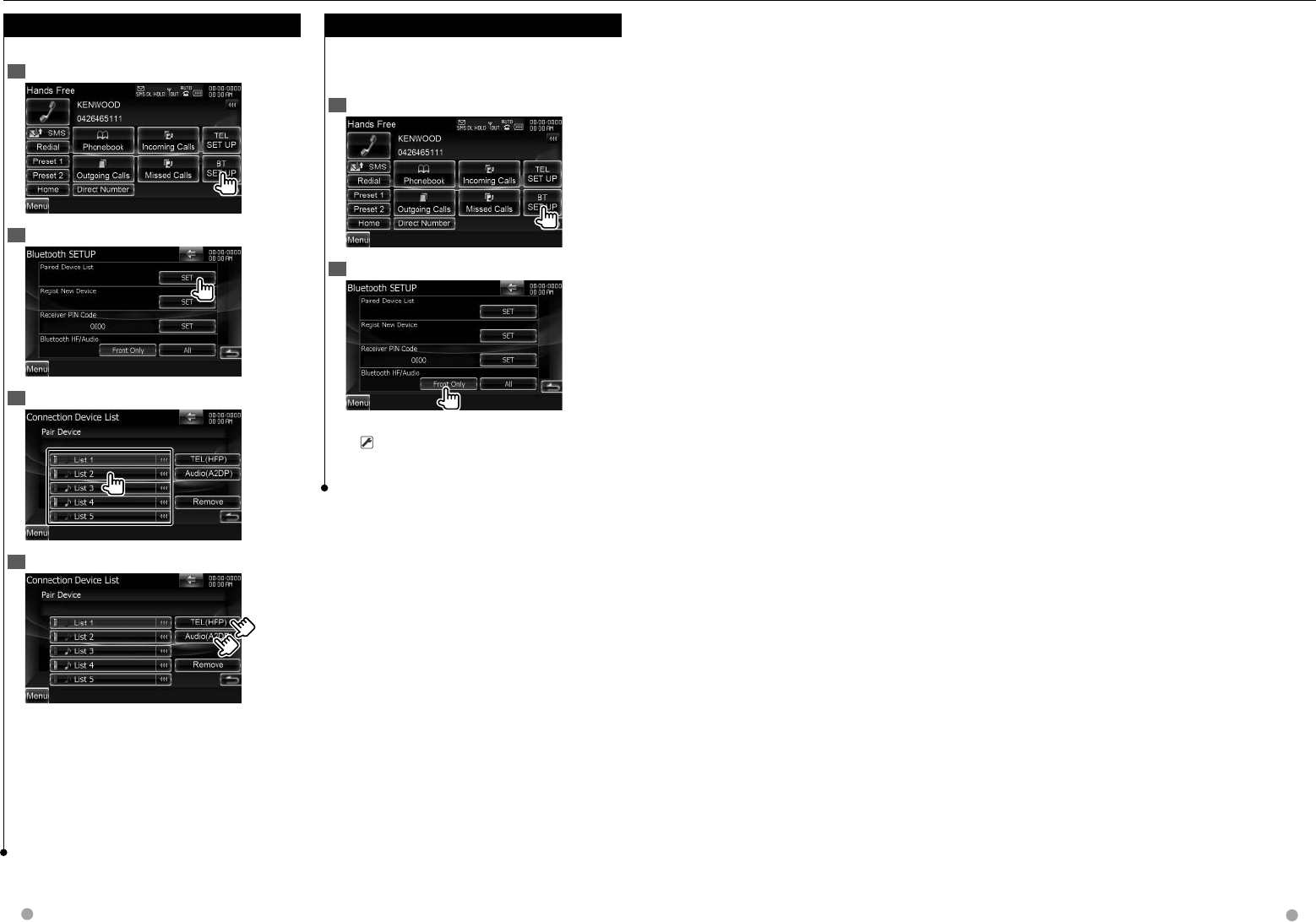
62 DNX9980HD English 63
Bluetooth Setup
Bluetooth Unit Connection
Bluetooth Unit Connection
Selects the Bluetooth unit to connect.
1 Display the Bluetooth Setup screen
2 Display the Connect Device List screen
3 Select a registered Bluetooth unit
4 Select the service to use
[TEL (HFP)] Connects/disconnects cell-phone to
use for Hands Free.
[Audio (A2DP)] Connects/disconnects Audio
player to use for Bluetooth Audio.
[Remove] Deletes registration (pairing).
Touching the screen displays a confirmation
message. Touch [Yes]. To cancel clearing, touch
[No].
Bluetooth Hands-Free/Audio Output Setup
Bluetooth Hands-Free/Audio Output Setup
Selects speakers to output the sound of hands-free
phoning (such as phone call voice and ringing
tone) and Bluetooth audio.
1 Display the Bluetooth Setup screen
2 Set the item
[Bluetooth HF/Audio] Sets the output speakers.
( "Front Only")
"Front Only": Outputs from the front speakers.
"All": Outputs from all the speakers.
DNX9980HD_K_English.indd 62-63 10/11/04 18:23
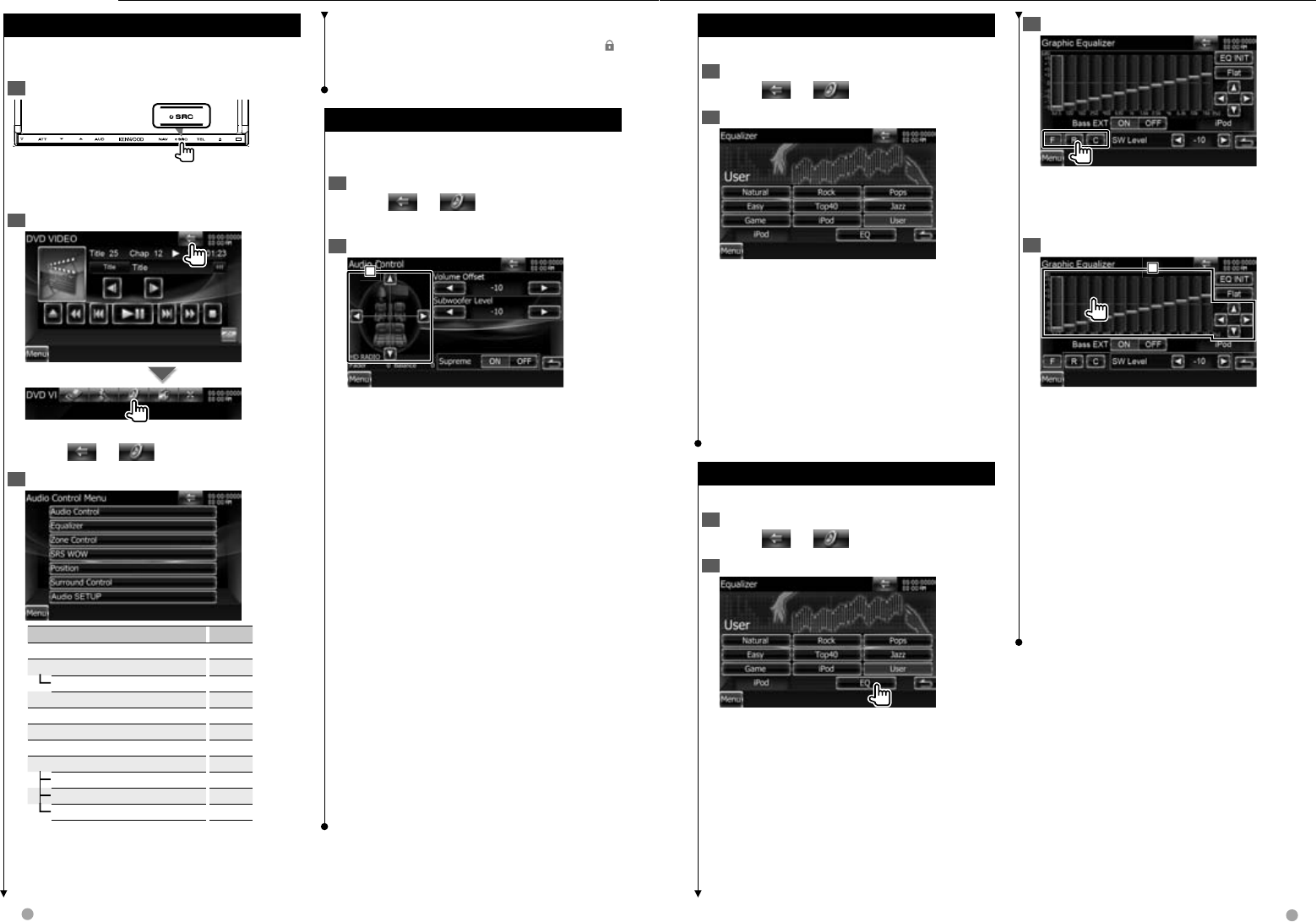
64 DNX9980HD English 65
Next page 3
Equalizer Control
Equalizer Control
You can set up the equalizer.
1 Display the Equalizer screen
Touch [ ]
>
> [ ]
>
> [Equalizer]. (page 64)
2 Select EQ curves
[Natural], [Rock], [Pops], [Easy], [Top40], [Jazz],
[Game], [iPod], [User]
Selects an equalizer curve type.
You can select any of the following equalizer
curves.
⁄
• [iPod]
During iPod source only.
[EQ] Displays the Graphic Equalizer setup screen.
(page 65)
Graphic Equalizer Setup
Graphic Equalizer Setup
You can Manually set the equalizer curve.
1 Display the Equalizer screen
Touch [ ]
>
> [ ]
>
> [Equalizer]. (page 64)
2 Display the Graphic Equalizer screen
⁄
• When "iPod" is selected in <Equalizer Control>, the
[EQ] button is deactivated. "iPod" uses its equalizer
function.
3 Select the channel to be adjusted
[F] Front speaker
[R] Rear speaker
[C] Center speaker
4 Set the Graphic Equalizer
1
1
1
1 Gain level can be adjusted by touching the
each frequency bar.
[2], [3] Sets a frequency.
[5], [∞] Sets a gain level.
[EQ Init] Returns to the previous level which the
gain level is adjusted.
[Flat] Tone curve becomes flat.
[Bass EXT] Bass Extend settings.
When turned on, the frequency lower than 62.5
Hz is set to the same gain level as 62.5Hz.
[SW Level] Adjusts the subwoofer volume.
The setting is available when subwoofer is set
to any item other than "None". See <Speaker
Setup> (page 69).
Audio Control Menu
Audio Control Menu
Displays the Audio Control menu to set the sound
effect function of this unit.
1 Display the Source Control Screen
When a video screen is displayed, press the [SRC]
button.
2 Display the Audio Control menu
In this manual, the above selection is indicated as:
Touch [ ]
>
> [ ].
3 Select the Audio Control item
Item Page
[Audio Control] 64
[Equalizer] 65
[EQ] 65
[Zone Control] 67
[SRS WOW] 67
[Position] 66
[Surround Control] 68
[Audio SETUP]
[Speaker Select] 69
[Car Type] 70
[Channel Level] 71
Audio Control
⁄
• [Audio SETUP] options can be locked. The key mark ( )
is displayed in reverse video for the locked option. See
<Setup Memory> (page 77).
Audio Control
Audio Control
You can adjust the front/rear and right/left audio
balance.
1 Display the Audio Control screen
Touch [ ]
>
> [ ]
>
> [Audio Control]. (page
64)
2 Set each item
1
1
1
1 Adjusts the front/back and left/right volume
around the touched area.
[2], [3] Adjusts the right and left volume
balance.
[5], [∞] Adjusts the front and rear volume
balance.
[Volume Offset] Finely adjust the volume of
the current source to minimize the difference in
volume between different sources.
⁄
• If you have increased the volume first, then reduced
the volume using the "Volume Offset", the sound
generated if you suddenly switch to another source
may be extremely loud.
[Subwoofer Level] Adjusts the subwoofer
volume.
The setting is available when subwoofer is set
to any item other than "None". See <Speaker
Setup> (page 69).
[Supreme] Turns ON/OFF the Supreme function.
Technology to extrapolate and supplement with
proprietary algorithm, the high-frequency range
that is cut off when encoding.
This function works on DVD, USB and iPod
sources.
DNX9980HD_K_English.indd 64-65 10/11/04 18:23
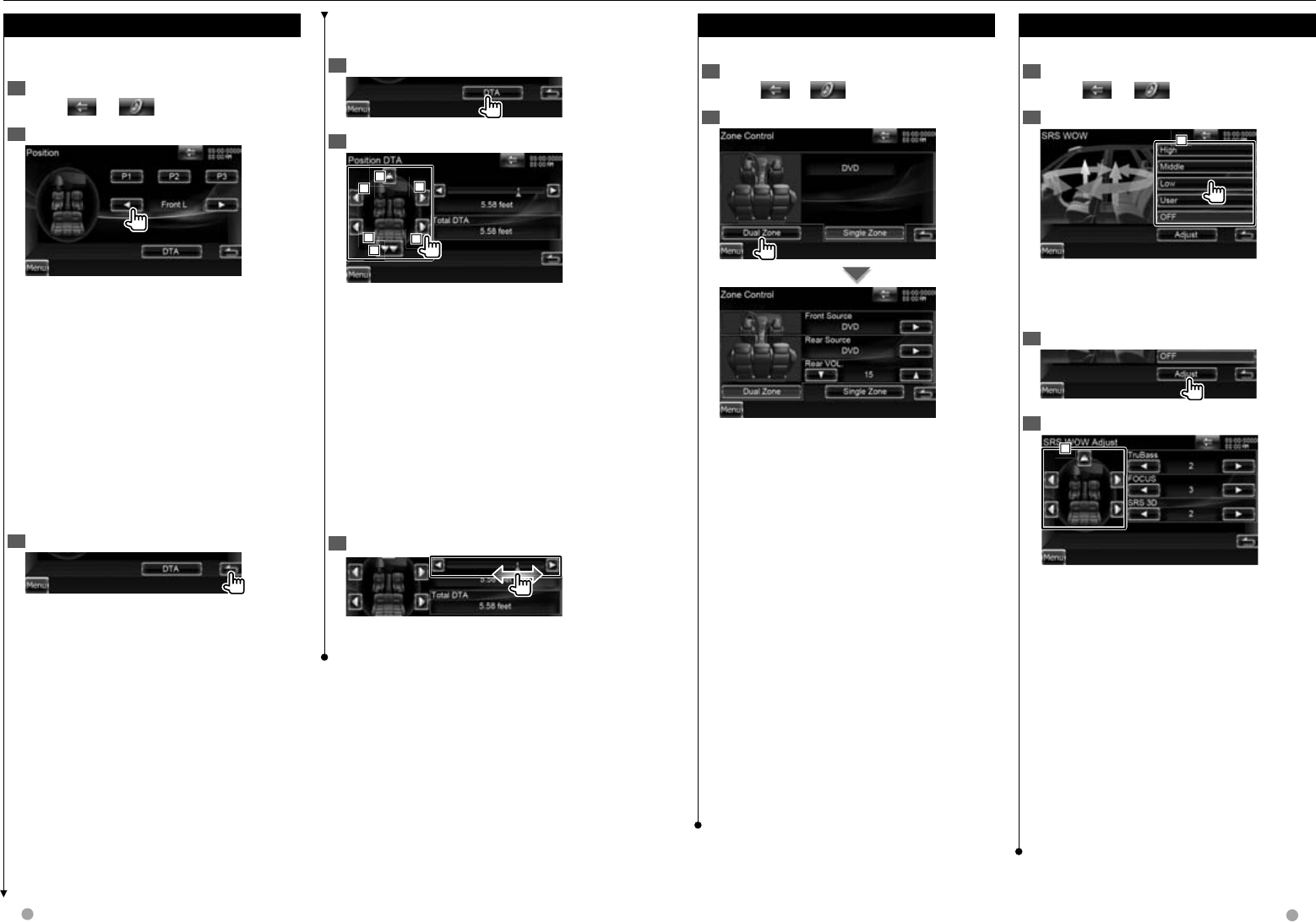
66 DNX9980HD English 67
Next page 3
Zone Control
Zone Control
You can set the front and rear audio source.
1 Display the Zone Control screen
Touch [ ]
>
> [ ]
>
> [Zone Control]. (page 64)
2 Set the Zone Control
[Single Zone] Sets the unit to single zone.
[Dual Zone] Sets the unit to dual zone.
[Front Source] Sets the front audio source.
[Rear Source] Sets the rear audio source.
⁄
• When the rear speaker sound is switched, the audio
source that is output at the AV OUTPUT terminal is
also switched to the same source.
[Rear VOL.] Adjusts the volume of the rear
channel.
⁄
• There are following limitations when zone function is
set to "ON".
- There is no output from the subwoofer or center
speaker.
- "Subwoofer Level", "Bass Boost", and "Supreme" of
<Audio Control> (page 64) is not available.
- <Equalizer Control> (page 65), <Listening Position>
(page 66), <SRS WOW Control> (page 67), and <Surround
Control> (page 68) are not available.
- <Speaker Setup> (page 69), <Car Type (DTA) Setup>
(page 70), and <Channel Level> (page 71) are not
available.
SRS WOW Control
SRS WOW Control
You can set up the SRS WOW effect.
1 Display the SRS WOW Control screen
Touch [ ]
>
> [ ]
>
> [SRS WOW]. (page 64)
2 Set the SRS WOW Control
1
1
1
1 Selects SRS WOW setting.
SRS WOW User Setup
1 Display the SRS WOW Adjust screen
2 Adjust the SRS settings
1
1
1
1 Selects a speaker to be set (Front, Rear or
Center speaker).
[TruBass] Sets the TruBass effect level.
[FOCUS] Sets the FOCUS effect level.
[SRS 3D] Sets the SRS 3D effect level.
⁄
• FOCUS: Adjusts the vertical position of the speaker and
sound image by virtual adjustment.
• TruBass: Assists the playback for the super bass sound.
• SRS 3D: Makes a natural 3D sound field.
• Some items cannot be adjusted depending on the
selected speaker.
• SRS WOW control is not available in TV source and HD
Radio source.
• When Surround Control is Dolby Pro Logic II, SRS WOW
control is not available.
Position DTA Control
You can fine-adjust your listening position.
1 Display the Position DTA screen
2 Select a speaker you wish to adjust
5
5
5
3
3
3
2
2
2
1
1
1
6
6
6
4
4
4
1 Center speaker
2 Left front speaker
3 Right front speaker
4 Left rear speaker
5 Right rear speaker
6 Subwoofer
[2], [3] Finely adjusts the value set with the
Position function.
[Total DTA] Indicates setup distance. The
adjusted distance (Position and Position DTA
values), and the total of the distance adjusted
by Car Type Set Up (page 70) and the adjustment
distance for position setup are indicated.
3 Finely adjust the distance
Finely adjust the value set with the Position
function.
Listening Position
Listening Position
You can adjust the sound effects according to your
listening position.
1 Display the Position screen
Touch [ ]
>
> [ ]
>
> [Position]. (page 64)
2 Set the Position Control
[P1] - [P3] Stores the present adjustment setup
in memory, or recalls it from memory.
To store your adjustment in memory:
Continue to touch [P1] to [P3] more than 2
seconds.
To call your adjustment from memory:
Touch [P1] to [P3] of your adjustment you wish
to recall from memory.
[2], [3] Sets a listening position.
You can select any of "Front R" (Right front),
"Front L" (Left front), "Front All" (All front), "All"
(All), and "User" (User) positions.
[DTA] Displays the Position DTA (Digital Time
Alignment) screen.
3 Exit Position Control
⁄
• The final distance is adjusted to the total of Car Type
Set Up value (page 70) and Position Setup (both Position
and Position DTA) value.
• If you change the Car Type Set Up value (page 70), the
position is set to "All".
• Only the adjusted distance of position setup (Position
and Position DTA values) is stored in memory. Therefore,
the final adjustment distance changes if you change
the Car Type Set Up value (page 70).
Audio Control
DNX9980HD_K_English.indd 66-67 10/11/04 18:23
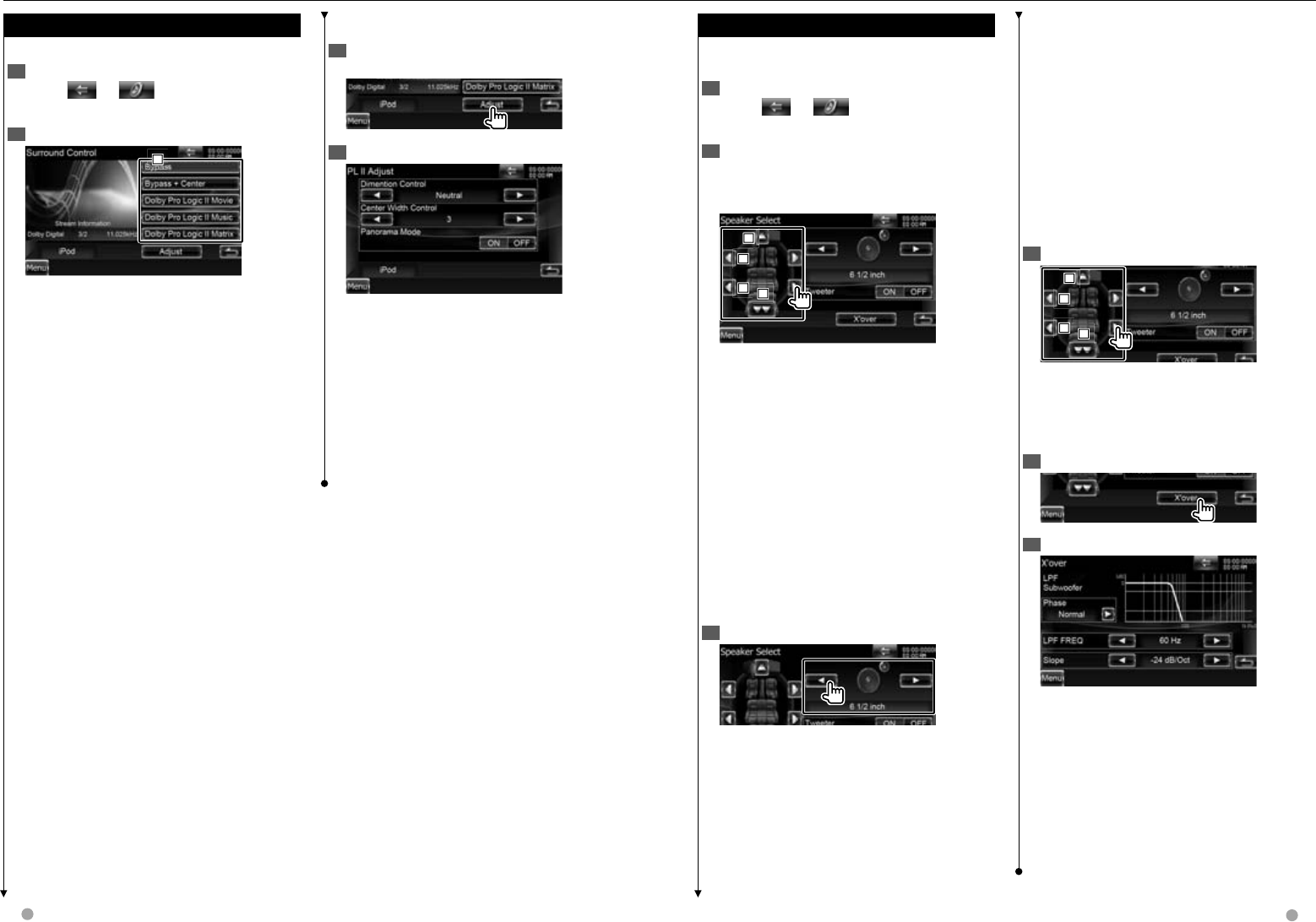
68 DNX9980HD English 69
Next page 3
Surround Control
Surround Control
You can set up the sound field.
1 Display the Surround Control screen
Touch [ ]
>
> [ ]
>
> [Surround Control].
(page 64)
2 Set the Surround Control
1
1
1
1 Sets a sound field.
You can select any of the following sound fields.
"Bypass"/ "Bypass+Center"/ "Dolby Pro Logic II
Movie"/ "Dolby Pro Logic II Music"/ "Dolby Pro
Logic II Matrix"
[Stream Information] Displays the present
source information.
The stream (Dolby Digital, dts, Linear PCM, MPEG,
SDDS, AAC or MP3/WMA), input channels (front
or rear channels), and sampling frequency are
displayed.
⁄
• When you have selected the TV source and when you
set the Dolby PL, we recommend you to select the
"Dolby PLII Matrix" mode. If you select another Dolby
PLII mode, the sound is NOT output from rear speakers
when you receive monaural broadcasting sounds.
• Surround control can be set for each source.
Dolby Pro Logic II Music Adjustment
1 Display the Dolby Pro Logic II Music Adjust
screen
2 Adjust the sound field
[Dimension Control] Sets the surround position
by adjusting the front and rear volume balance.
[Center Width Control] Sets the vocal image
position by adjusting the right and left vocal
volume level.
[Panorama Mode] Turns the Panorama mode
On or Off.
⁄
• You cannot use the <Surround Control Adjustment>
during playback of a Multi-channel source.
Audio Control
Speaker Setup
Speaker Setup
You can select a speaker type and its size to get the
best sound effects.
1 Display the Speaker Select screen
Touch [ ]
>
> [ ]
>
> [Audio SETUP]
>
>
[Speaker Select]. (page 64)
2 Select a speaker you wish to adjust
When the speaker type and size are set, the
speaker crossover network and equalizer curve are
set automatically.
2
2
2
1
1
1
3
3
3
4
4
4
1 Center speaker
2 Front speaker
3 Rear speaker
4 Subwoofer
[Tweeter] You can set the tweeter when you are
selecting front speakers.
If you are using a tweeter together with the front
speakers, set the tweeter to "ON". In the "ON"
position, the Equalizer is adjusted to its best
position.
[X'over] Displays the Speaker Crossover Setup
screen.
You can adjust the crossover setup that was set
automatically when you selected the speaker
type.
3 Select a speaker type
You can select any of the following speaker types.
"Center" None, 2-3/4x1-9/16 inch, 2 inch, 4 inch,
5 inch, 6-1/2 inch over
"Front" OEM, 4 inch, 5 inch, 6-1/2 inch, 6-3/4 inch,
7 inch, 4x6, 5x7, 6x8, 6x9, 7x10
"Rear" None, OEM, 4 inch, 5 inch, 6-1/2 inch,
6-3/4 inch, 7 inch, 4x6, 5x7, 6x8, 6x9, 7x10
"Subwoofer" None, 6 1/2 inch, 8 inch, 10 inch, 12
inch, 15 inch over
⁄
• Select "None" if you have no speakers.
• If you set the center speaker to "None" even in a short
time when you are setting the Surround Control to
"Bypass+Center", the Surround Control is set to "Bypass"
automatically. See <Surround Control> (page 68).
• If you set the center and rear speakers to "None" when
you are setting the Surround Control to "Dolby PL II",
the Surround Control is set to "Bypass" automatically.
See <Surround Control> (page 68).
Crossover Network Setup
You can set a crossover frequency of speakers.
1 Select the speaker to set the crossover
2
2
2
1
1
1
3
3
3
4
4
4
1 Sets the High Pass Filter of the center speaker.
2 Sets the High Pass Filter of the front speaker.
3 Sets the High Pass Filter of the rear speaker.
4 Sets the Low Pass Filter of the subwoofer.
2 Display the Crossover setup screen
3 Set the crossover
[Phase] Sets the phase of subwoofer output.
The phase is reversed 180 degrees when set to
"Reverse". (Only when "Subwoofer" is set to any
item other than "None" in Speaker Setup)
[HPF FREQ] High Pass Filter adjustment. (When
front, center or rear speaker is selected on
Speaker Select screen)
[LPF FREQ] Low Pass Filter adjustment. (When
Subwoofer is selected on Speaker Select screen)
[Slope] Sets a crossover slope.
DNX9980HD_K_English.indd 68-69 10/11/04 18:23
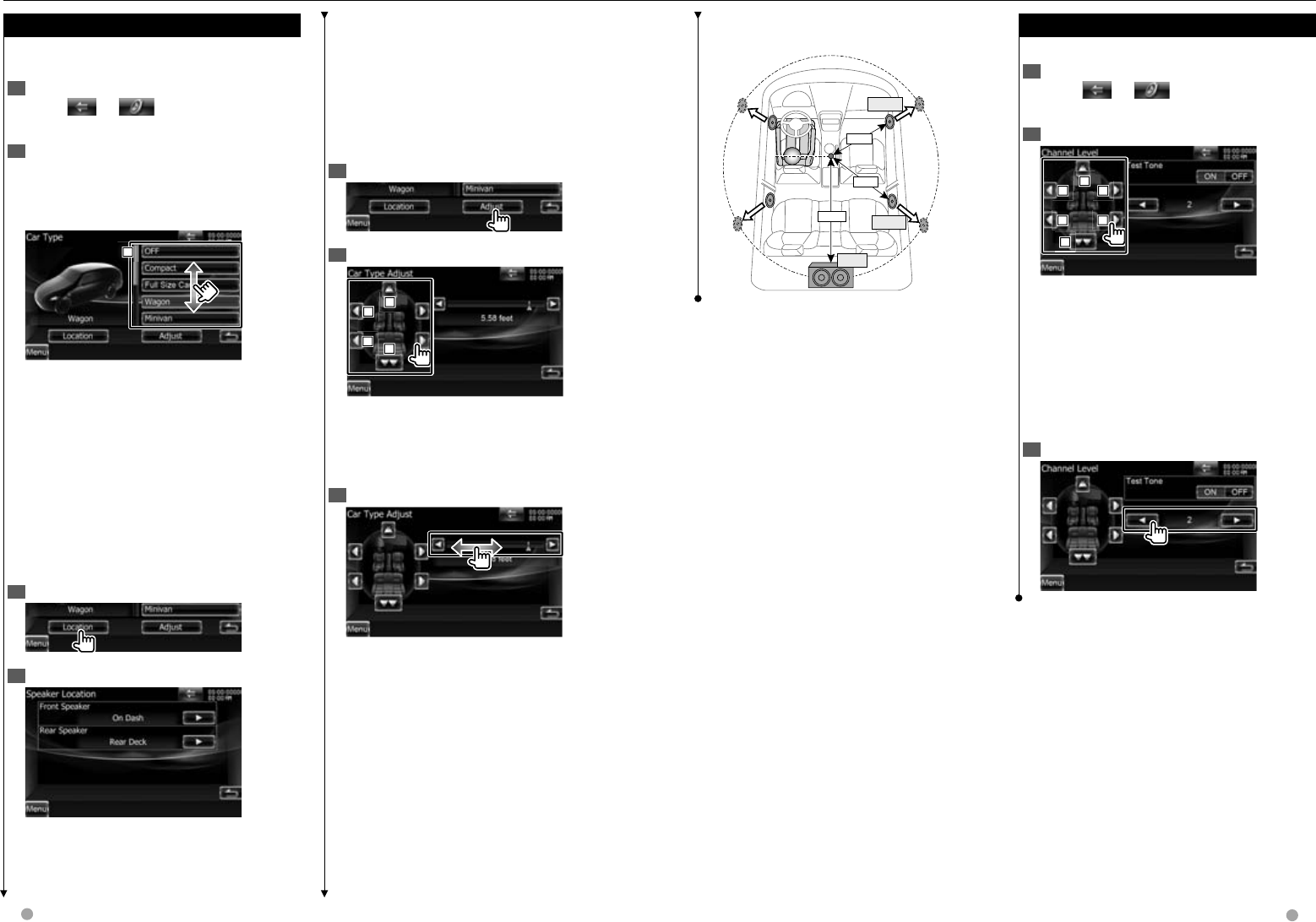
70 DNX9980HD English 71
Car Type (DTA) Setup
Car Type (DTA) Setup
You can setup the car type and speaker network,
etc.
1 Display the Car Type Setup screen
Touch [ ]
>
> [ ]
>
> [Audio SETUP]
>
> [Car
Type]. (page 64)
2 Setup the Car Type
If your car type is selected, the Digital Time
Alignment and Equalizer is set automatically (for
timing adjustment of sound output for each
channel) to have the highest surround effects.
1
1
1
1 Sets up the car type you use together with
this unit.
You can choose according to type of your car.
"OFF", "Compact", "Full Size Car", "Wagon",
"Minivan", "SUV", "Minivan (Long)"
[Location] Sets the locations of the speakers.
[Adjust] Displays the Car Type Adjust screen.
You can adjust the digital time alignment that
was set automatically when you selected the
car type.
Speaker Location setup
1 Display the Speaker Location Setup screen
2 Set the speaker locations
[Front Speaker] Sets the location of the front
speaker.
"Door", "On Dash", "Under Dash"
[Rear Speaker] Sets the location of the rear
speaker.
"Door", "Rear Deck"
"2nd Row", "3rd Row" (Minivan, Minivan (Long))
Car Type Adjust
You can manually set the sound output timing of
each channel.
1 Display the Car Type Adjust screen
2 Select a speaker you wish to adjust
2
2
2
1
1
1
3
3
3
4
4
4
1 Center speaker
2 Front speaker
3 Rear speaker
4 Subwoofer
3 Set a delay time
Make fine adjustment of the delay time of the
speaker output specified at <Setup the Car Type>
to have a more suitable environment for your
vehicle.
The settings of the delay time are automatically
identified and compensated by specifying the
distances of each speaker from the center of the
vehicle interior.
1 Set the front and rear positions and the height
of the reference point to the position of the ears
of the person sitting in the front seat, and set
the right and left positions to the center of the
vehicle interior.
2 Measure the distances from the reference point
to the speakers.
3 Calculate the distance difference in accordance
with the farthest speaker.
1.6feet
2.5feet
5feet +2.5feet
+0feet
+3.4feet
Channel Level
Channel Level
You can set the volume at each setup position.
1 Display the Car Type Setup screen
Touch [ ]
>
> [ ]
>
> [Audio SETUP]
>
>
[Channel Level]. (page 64)
2 Select a speaker you wish to adjust
2
2
2
1
1
1
4
4
4
3
3
3
5
5
5
6
6
6
1 Center speaker
2 Left front speaker
3 Right front speaker
4 Left rear speaker
5 Right rear speaker
6 Subwoofer
[Test Tone] Starts or stops test signal tone output
for setup check.
3 Adjust the volume
DNX9980HD_K_English.indd 70-71 10/11/04 18:23
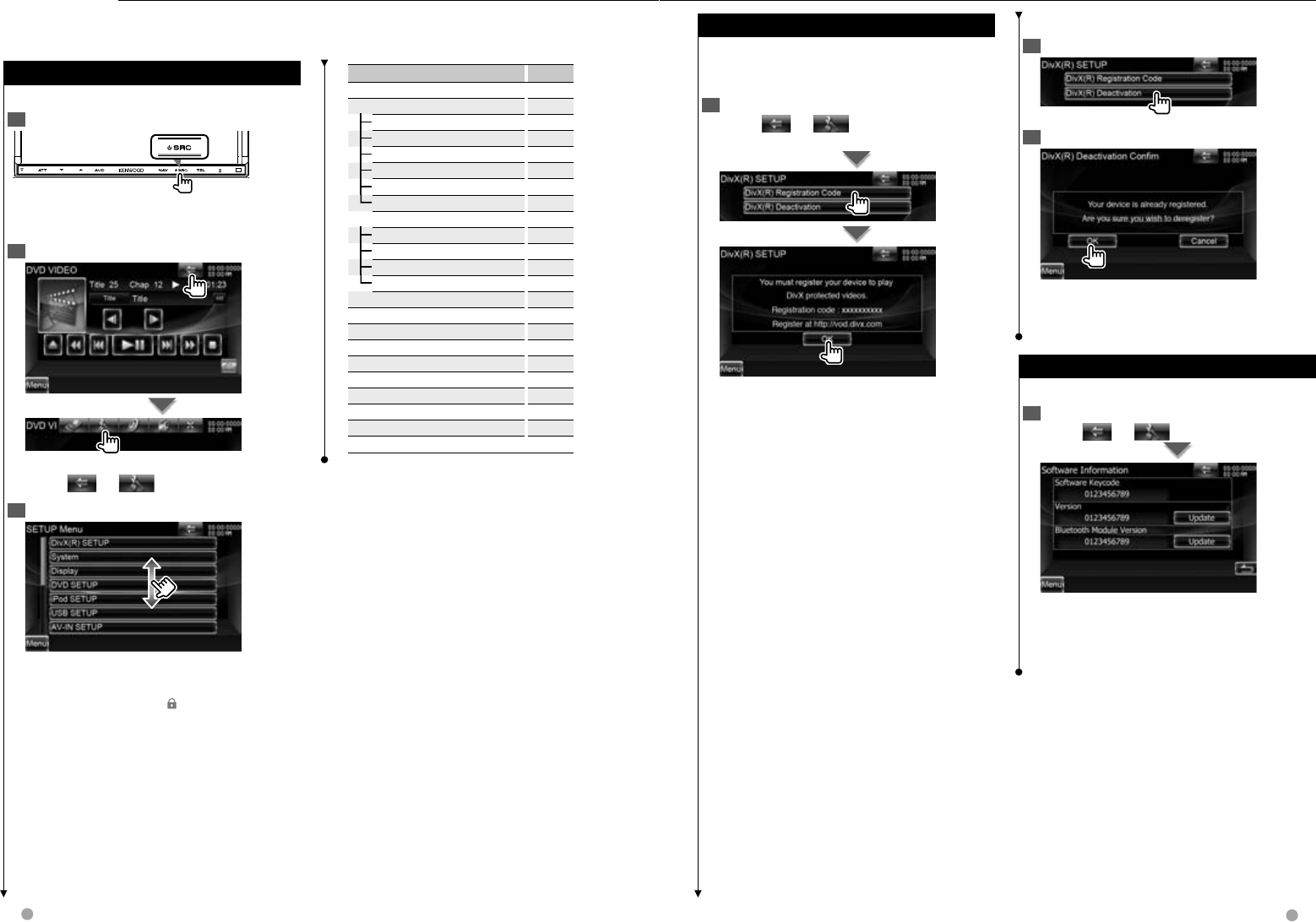
72 DNX9980HD English 73
Next page 3
DivX Setup
DivX Setup
Checks the registration code. This code is needed
when making a disc which has DRM (Digital Rights
Management).
1 Display the DivX Setup screen
Touch [ ]
>
> [ ]
>
> [DivX(R) SETUP]. (page
72)
Displays the registration code.
⁄
• Disabled when a DVD is being played.
• When downloading a DivX VOD file controlled by
DRM, register the code appeared on the screen such
as the one above. Otherwise the file may not be able
to play with this unit. Remaining number of viewing
is displayed when playing a DivX VOD file with the
viewing restriction. When the remaining number of
viewing reached 0, a warning message appears and the
file cannot be played.
Deactivating DivX Code
1 Display the DivX Deactivation Confirm screen
2 Cancel the registration
Touching the screen displays a confirmation
message. Touch [OK].
To cancel clearing, touch [Cancel].
Software Information
Software Information
Checks the software version of this unit.
1 Display the Software Information screen
Touch [ ]
>
> [ ]
>
> [Software]. (page 72)
Displays the software version.
⁄
• For how to update the software, refer to the relevant
update procedure manual which comes with the software.
Setup Menu
How to Display SETUP Menu Screen
How to Display SETUP Menu Screen
Displays the Setup menu to set various functions.
1 Display the Source Control Screen
When a video screen is displayed, press the [SRC]
button.
2 Display the Setup Menu Screen
In this manual, the above selection is indicated as:
Touch [ ]
>
> [ ].
3 Select the setup item
⁄
• [AV-IN SETUP], [Navigation] and [Audio SETUP] options
can be locked. The key mark ( ) is displayed in reverse
video for the locked option. See <Setup Memory>
(page 77).
You can set up various receiver parameters.
Item Page
[DivX(R) SETUP] 73
[System]
[User Interface] 74
[Touch] 75
[Clock] 75
[Security] 76
[EXT SW] 76
[SETUP Memory] 77
[Display]
[Screen Adjust] 80
[Angle] 76
[Color] 79
[Background] 78
[SIRIUS SETUP] 86
[DVD SETUP] 82
[iPod SETUP] 85
[USB SETUP] 85
[TV SETUP] 88
[AV-IN SETUP] 80
[Navigation] 82
[Software] 73
[AV-OUT Interface] 81
[Camera SETUP] 81
DNX9980HD_K_English.indd 72-73 10/11/04 18:23
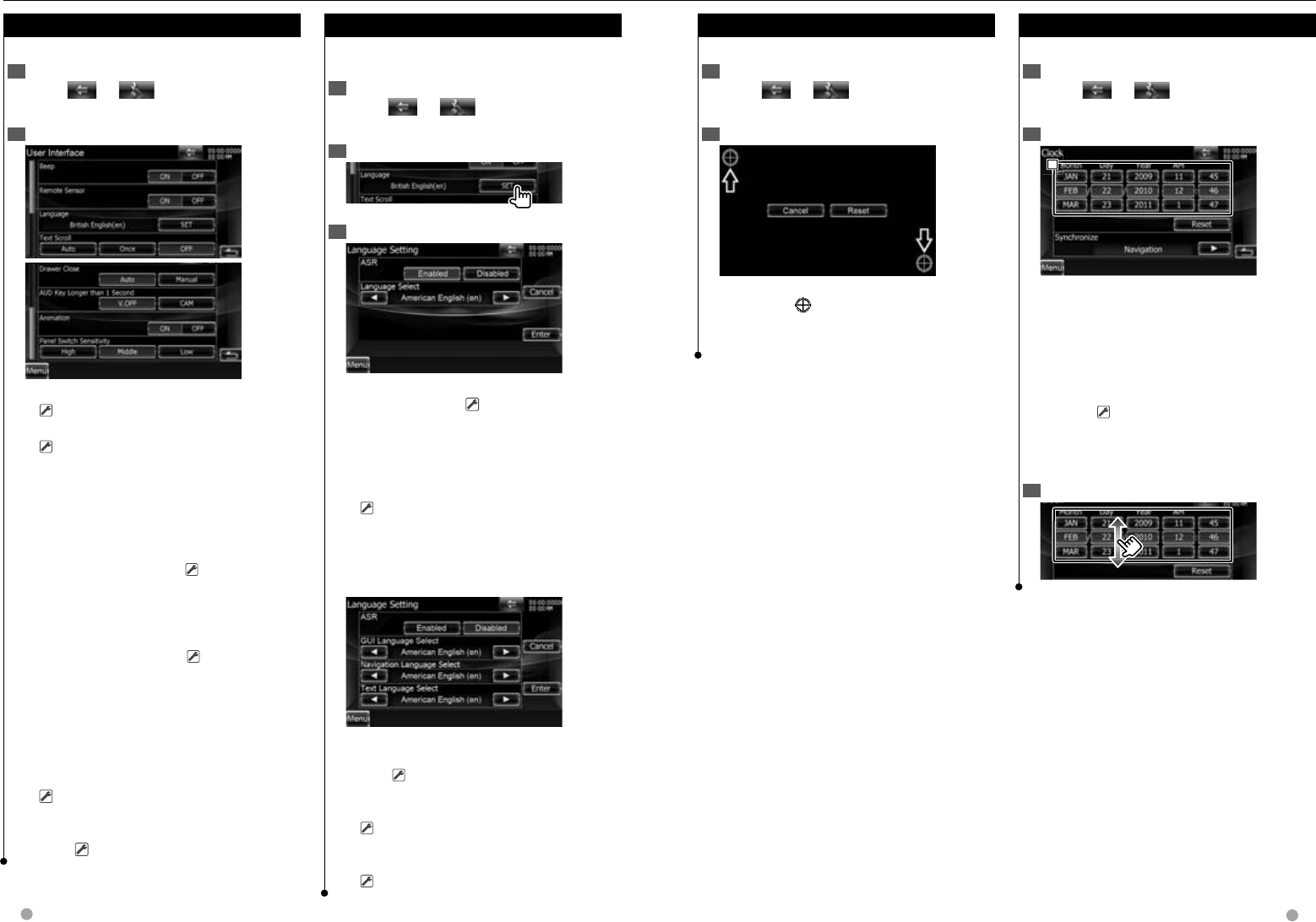
74 DNX9980HD English 75
Next page 3
Touch Panel Adjustment
Touch Panel Adjustment
You can adjust the touch panel operations.
1 Display the Touch panel Adjustment screen
Touch [ ]
>
> [ ]
>
> [System]
>
> [Touch].
(page 72)
2 Adjust the Touch panel
Follow the instruction on the screen and touch
the center of .
[Cancel] Cancels the Touch Panel Adjust.
[Reset] Resets to the initial status.
Clock and Date Setup
Clock and Date Setup
You can adjust the clock time.
1 Display the Clock Setup screen
Touch [ ]
>
> [ ]
>
> [System]
>
> [Clock].
(page 72)
2 Setup the Clock
1
1
1
1 Adjusts month, day, year, hours, and minute.
[Reset] Sets "00" minute.
Setup examples: 3:00 – 3:29 \ 3:00
3:30 – 3:59 \ 4:00
[Synchronize] Sets the clock time in
synchronization with the time data sent from
the navigation system or the Radio Data System
station. ( "Navigation")
"OFF"/ "RDS"/ "Navigation"
When the synchronized mode is set, the clock
cannot be adjusted manually.
3 Adjust the date or clock time
Setup Menu
Language Setting
Language Setting
You can select the display language for the control
screen and audio file tags.
1 Display the User Interface screen
Touch [ ]
>
> [ ]
>
> [System]
>
> [User
Interface]. (page 72)
2 Display the Language Setting screen
3 Select a language
[ASR] Selects whether to use the voice control
function. (page 51) ( "Enabled")
Touching [Disabled] allows you to select
languages for respective items.
"Enabled": Voice control is activated.
"Disabled": Voice control is deactivated.
[Language Select] Selects a language.
( "American English (en)")
[Enter] Determines the selected language.
[Cancel] Cancels the selected language.
When [ASR] is set to "Disabled"
[GUI Language Select] Selects the display
language used for the control screen and so
forth. ( "American English (en)")
[Navigation Language Select] Selects the
language used for navigation.
( "American English (en)")
[Text Language Select] Selects the language
used for tag text (song information).
( "American English (en)")
User Interface
User Interface
You can setup user interface parameters.
1 Display the User Interface screen
Touch [ ]
>
> [ ]
>
> [System]
>
> [User
Interface]. (page 72)
2 Set each item
[Beep] Turns the key touch tone On or Off.
( "ON")
[Remote Sensor] Selects a remote control signal.
( "ON")
When turned "OFF", the remote control of TV
reception is rejected.
[Language] Select the language used for the
control screen and setting items. See <Language
Setting> (page 74).
[Text Scroll] Allows scrolling of text display on
the Source Control screen. ( "Manual")
"Auto": Scrolls the screen automatically.
"One": Scrolls the screen only once.
"OFF": Allows you to scroll the screen manually.
[Drawer Close] Sets whether to close the
function bar automatically. ( "Auto")
[AUD Key Longer than 1 Second] Sets the
function of the [AUD] button. (page 12)
"V.OFF": Press the [AUD] button for longer than 1
second to turn the display off.
"CAM": Press the [AUD] button for longer than 1
second to switch to camera view.
[Animation] Sets whether to display animation.
( "ON")
[Panel Switch Sensitivity] Adjusts the sensitivity
of the buttons (touch sensors) on the front
panel. ( "Middle")
DNX9980HD_K_English.indd 74-75 10/11/04 18:23
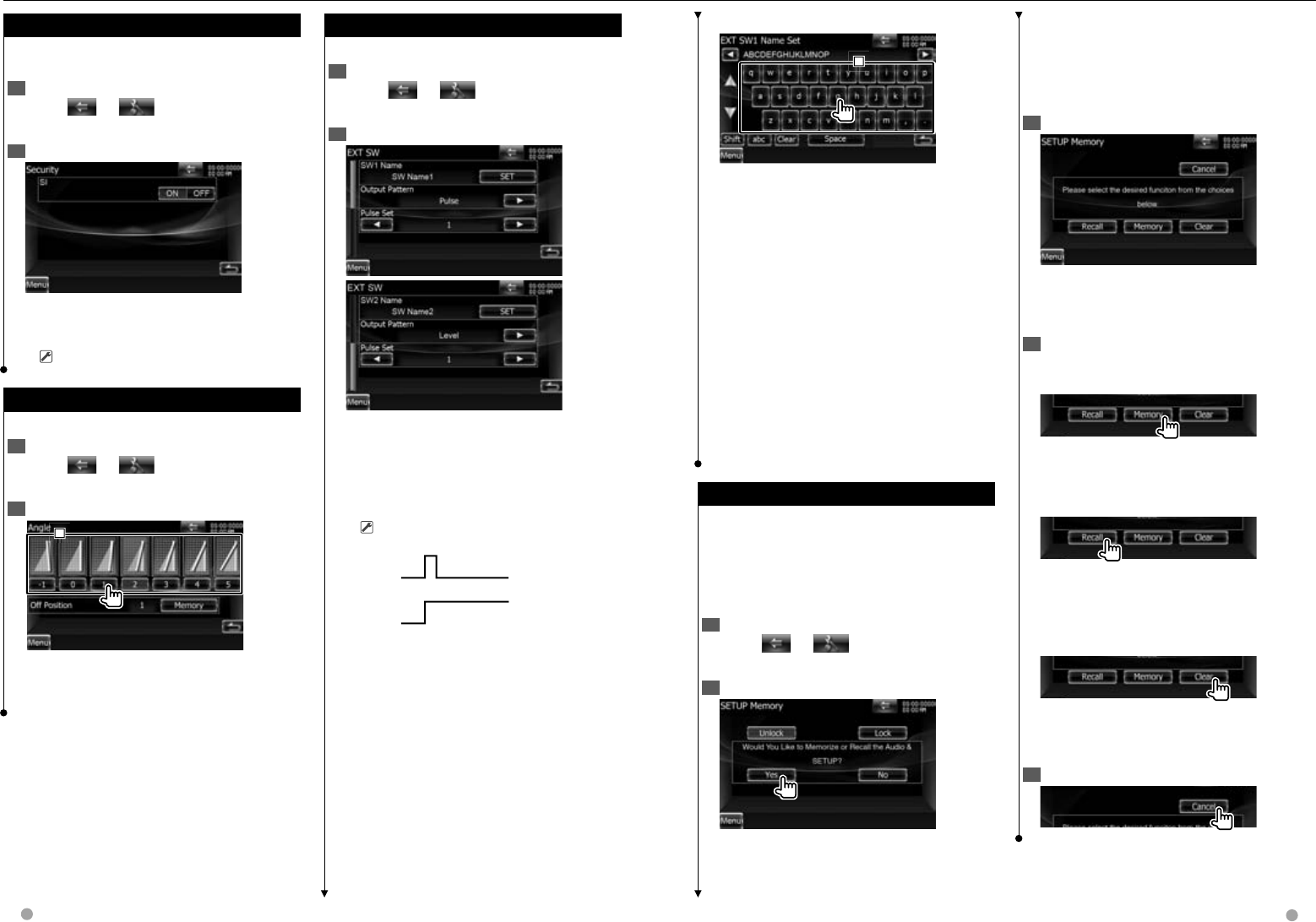
76 DNX9980HD English 77
Next page 3
How To Use the Character Entry Screen
1
1
1
1 Enters characters.
[2], [3] Shifts the cursor.
[5], [∞] Switches between key layouts.
[Shift] Toggles between uppercase and
lowercase.
[qwe]/ [abc] Sets the key layout of the character
buttons.
abc : Alphabetical key layout.
qwe : Qwerty key layout.
[Clear] Clears the character.
If you erase a character, locate the cursor on it
and touch this button.
[Space] Enters a space.
⁄
• You can enter characters only after you have applied
the parking brake.
Setup Memory
Setup Memory
Audio Control, AV-IN SETUP, AV Interface,
Navigation, and Audio SETUP settings can be
memorized. The memorized settings can be
recalled at any time. For example, even when the
settings are cleared due to replacement of the
battery, the settings can be restored.
1 Display the SETUP Memory screen
Touch [ ]
>
> [ ]
>
> [System]
>
> [SETUP
Memory]. (page 72)
2 Start Setup Memory
[Lock] Locks the AV-IN SETUP, Navigation, and
Audio SETUP settings. When [Lock] is selected,
you cannot change the AV-IN SETUP, Navigation,
and Audio SETUP settings.
[Yes] Memorizes or recalls the settings.
[No] To cancel the function, touch [No]. To cancel
memorization, touch [No].
The SETUP Menu screen appears again.
3 Select a desired function
[Recall] Recalls the memorized settings.
[Memory] Memorizes the current settings.
[Clear] Clears the currently memorized settings.
4 Memorize or recall the settings
When memorizing the Audio Setup and AV
Interface settings:
If settings have already been memorized, a
confirmation message appears. Touch [Yes]. To
cancel memorization, touch [No].
When recalling the memorized settings:
Touching the screen displays a confirmation
message. Touch [Yes]. To cancel recalling, touch
[No].
When clearing the currently memorized
settings:
Touching the screen displays a confirmation
message. Touch [Yes]. To cancel clearing, touch
[No].
5 Quit memorization/recalling of settings
Setup Menu
Security Setup
Security Setup
A red indicator will blink on the unit after the ACC
is set to OFF, warning potential thieves.
1 Display the Security screen
Touch [ ]
>
> [ ]
>
> [System]
>
> [Security].
(page 72)
2 Setup the SI (Security Indicator)
[SI] Turns the SI function on or off.
If turned "ON", the security indicator on the front
panel flashes when the vehicle ignition is off.
( "ON")
Monitor Angle Control
Monitor Angle Control
You can adjust the position of the monitor.
1 Display the Angle Setup screen
Touch [ ]
>
> [ ]
>
> [System]
>
> [Angle].
(page 72)
2 Set the Monitor Angle
1
1
1
1 Sets the Monitor angle.
[Off Position] Stores the current monitor angle
as the angle during power off.
EXT SW Setup
EXT SW Setup
Sets up the exteral switch power mode.
1 Display the EXT SW screen
Touch [ ]
>
> [ ]
>
> [System]
>
> [EXT SW].
(page 72)
2 Perform EXT SW Setup
[SW1 Name]/ [SW2 Name] Sets the name of the
external device. See <How To Use the Character
Entry Screen> (page 77) for information on how to
enter a name.
[Output Pattern] Sets the power signal output
mode.
( EXT SW1: Pulse, EXT SW2: Level)
"Pulse": Generates a single power signal pulse.
"Level": Continues output of high power signal.
Sets to turn output on/off each time the button
on the EXT SW Control screen is touched. See
<External Device Power Supply Control> (page
50).
[Pulse Set] Sets the Pulse signal output time.
Outputs 500ms when "1" is set. Increases by
200ms with each step. Up to 100 steps can be
set.
DNX9980HD_K_English.indd 76-77 10/11/04 18:23
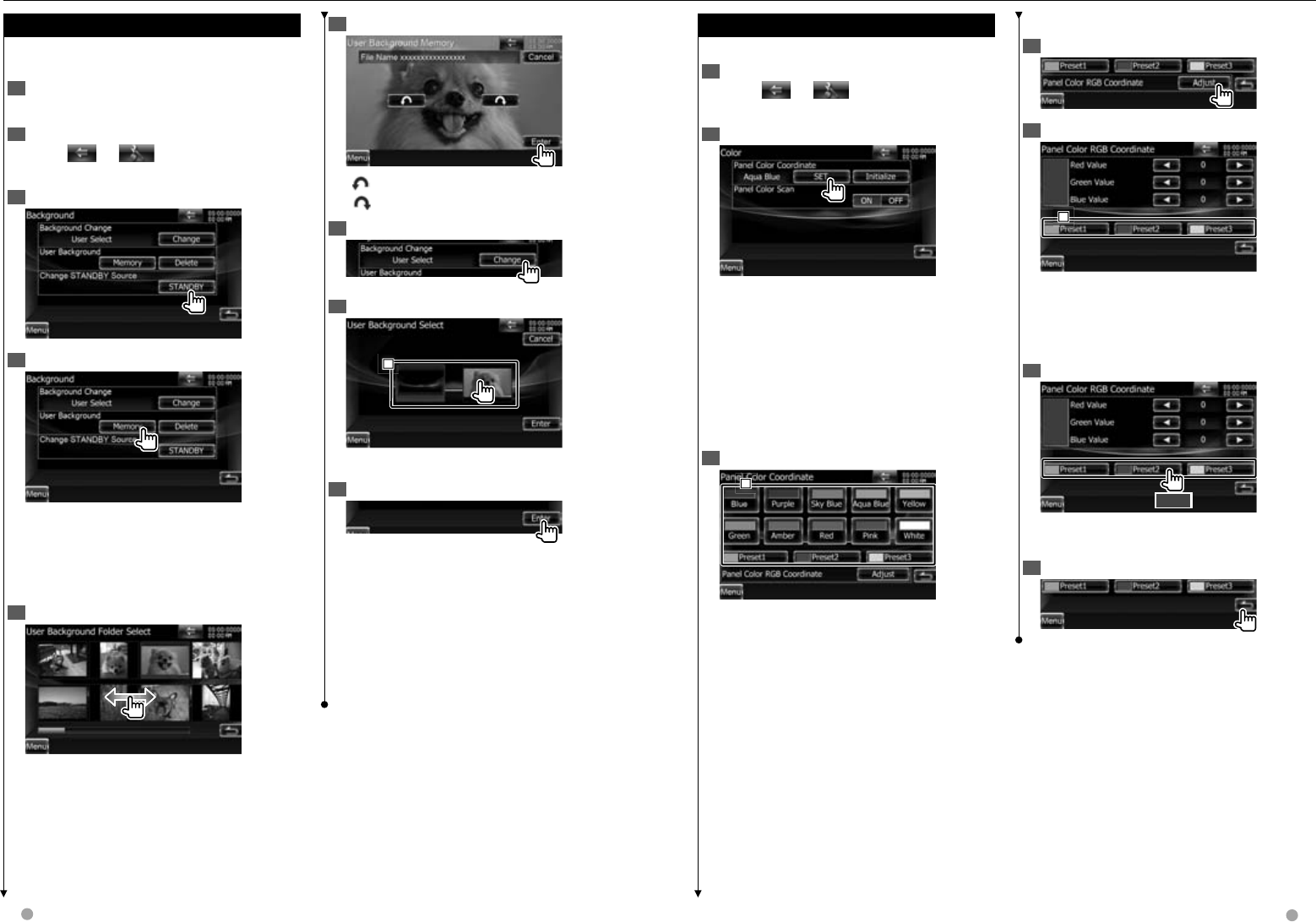
78 DNX9980HD English 79
Next page 3
Panel Color Coordinate
Panel Color Coordinate
Sets the button illumination color.
1 Display the Color screen
Touch [ ]
>
> [ ]
>
> [Display]
>
> [Color].
(page 72)
2 Display the Panel Color Coordinate screen
[Initialize] Initialization resets the settings made
using the Panel Color SET process to the default
settings set at the factory.
[Panel Color Scan] When set to "ON", the
illumination color of the screen and buttons
changes one after another.
⁄
• When touching [SET] or [Initialize], make sure [Panel
Color Scan] is set to "OFF".
3 Select a color
1
1
1
1 Sets to the touched color.
[Adjust] Sets and registers favorite color to the
preset buttons ([Preset1] – [Preset3]).
To register your original color
1 Start the RGB coordinate
2 Adjust each color value
1
1
1
1 Selects a preset number to register.
[Red Value] Adjusts the Red value.
[Green Value] Adjusts the Green value.
[Blue Value] Adjusts the Blue value.
3 Select a Preset number to register
2 sec.
Adjusted color is registered to the selected Preset
button.
4 Complete the color coordination
Setup Menu
Changing Background image
Changing Background image
Loads an image from the connected USB device
and sets it for the background image.
1 Connect the device which has the image to
load
2 Display the Background screen
Touch [ ]
>
> [ ]
>
> [Display]
>
>
[Background]. (page 72)
3 Change Standby
4 Display the Background Memory screen
[Change] Selects an image for background.
[Delete] Deletes the background image.
Touching the screen displays a confirmation
message. Touch [Yes]. To cancel clearing, touch
[No].
5 Select the image to load
6 Load the image
[] Rotates counter clockwise.
[] Rotates clockwise.
7 Select Background Change screen
8 Select an image for background
1
1
1
1 Returns to the initial background.
9 Set the image as the background
⁄
• See <About Picture files> (page 6) for readable image
specifications.
• The [Memory] button on the “Background” screen
becomes active only in STANDBY source mode.
• Pressing the [Memory] button on the “Background”
screen switches the AV OUT source to OFF. For resetting
the AV OUT source, refer to <AV Output Interface
Setup> (page 81).
DNX9980HD_K_English.indd 78-79 10/11/04 18:23
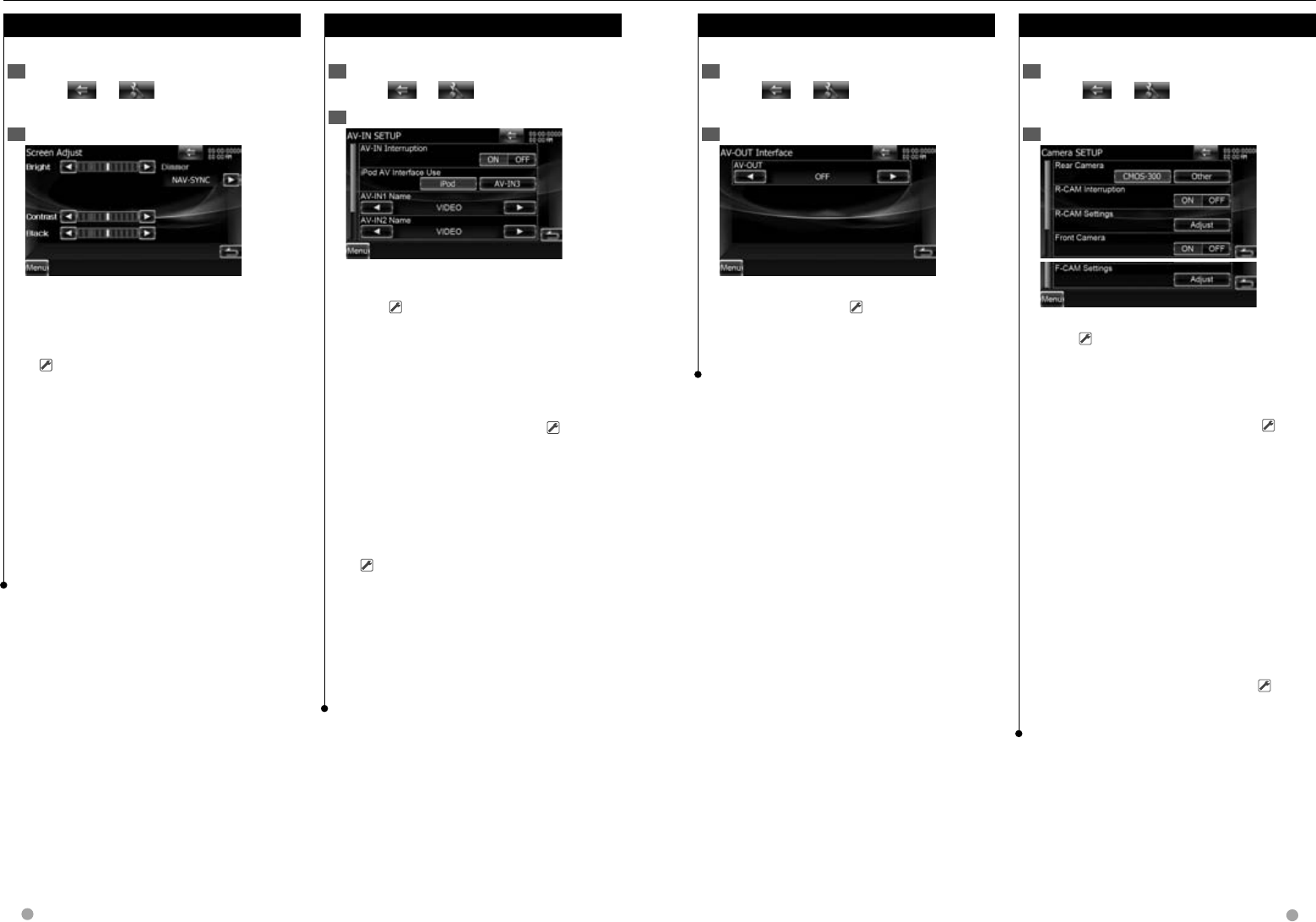
80 DNX9980HD English 81
Next page 3
AV Output Interface Setup
AV Output Interface Setup
You can set AV output parameters.
1 Display the AV-OUT Interface screen
Touch [ ]
>
> [ ]
>
> [AV-OUT Interface].
(page 72)
2 Set each item
[AV-OUT] Selects an AV source to be output at
the AV OUTPUT port. ( "VIDEO1")
⁄
• USB source cannot be selected when two iPods are
connected.
Camera Setup
Camera Setup
You can set Camera parameters.
1 Display the Camera Setup screen
Touch [ ]
>
> [ ]
>
> [Camera SETUP]. (page
72)
2 Set each item
[Rear Camera] Selects the type of rear camera to
use. ( "Other")
"CMOS-300": When the CMOS-300 with ID 1 set
is connected.
"Other": When the other camera is connected.
[R-CAM Interruption] Sets a method to switch
to the rear view camera video display. ( "OFF")
"ON": Switches to the rear view camera video
display when engaging the shift knob of car to
"Reverse" and then pressing the [AUD] button
for longer than 1 second.
"OFF": Switches to the rear view camera video
display, press the [AUD] button for longer than
1 second.
⁄
• The function of the [AUD] button needs to be
set to "CAM" in [AUD Key Longer than 1 Second]
beforehand.
[R-CAM Settings] Adjusts the CMOS-300 with ID
1 set. For details, see the option manual.
[Front Camera] Turn this setting on when the
CMOS-300 with ID2 set is connected. ( "OFF")
[F-CAM Settings] Adjusts the CMOS-300 with ID
2 set. For details, see the option manual.
Setup Menu
Screen Control
Screen Control
You can adjust the screen mode of the monitor.
1 Display the Screen Control screen
Touch [ ]
>
> [ ]
>
> [Display]
>
> [Screen
Adjust]. (page 72)
2 Set each item
[Bright] Brightness Control
[Contrast] Contrast Control
[Black] Black Level Adjustment
[Dimmer] Dimmer Mode Setup
( "SYNC")
"ON": The display dims.
"OFF": The display doesn’t dim.
"SYNC": Turning the Dimmer function On or Off
when the vehicle light control switch is turned
On or Off.
"NAV-SYNC": Turning the Dimmer function On
or Off according to the Navigation Day/Night
display setting.
⁄
• In this Screen Control screen, you can perform setups
for the menu screen. Setups for videos such as DVD can
be performed on the <Screen Control> (page 52).
AV Input Setup
AV Input Setup
You can set AV input parameters.
1 Display the AV-IN Setup screen
Touch [ ]
>
> [ ]
>
> [AV-IN SETUP]. (page 72)
2 Set each item
[AV-IN Interruption] Sets an image display of
the system that is connected via the AV INPUT
port. ( "OFF")
"OFF": When the image source is switched,
an image entered via the AV INPUT port is
displayed.
"ON": When an image signal is entered via the
AV INPUT port, this image is displayed.
[iPod AV Interface Use] You can determine the
use of iPod/AV-IN3 input terminal. ( "iPod")
"iPod": Select when connecting the iPod using
the KCA-iP302 for iPod.
"AV-IN3": Select to play an AV component
connected to the iPod/AV-IN3 input terminal.
[AV-IN1 Name], [AV-IN2 Name], [AV-IN3 Name]
Sets a name to be displayed when you select a
system that is connected via the AV INPUT port.
( "VIDEO")
⁄
• [iPod AV Interface Use]
This item can be set when in STANDBY source and also
the iPod is disconnected.
• [AV-IN Name]
Two AV-IN names are displayed when "iPod" is selected in
[iPod AV Interface Use] and three are displayed when not
selected.
DNX9980HD_K_English.indd 80-81 10/11/04 18:23
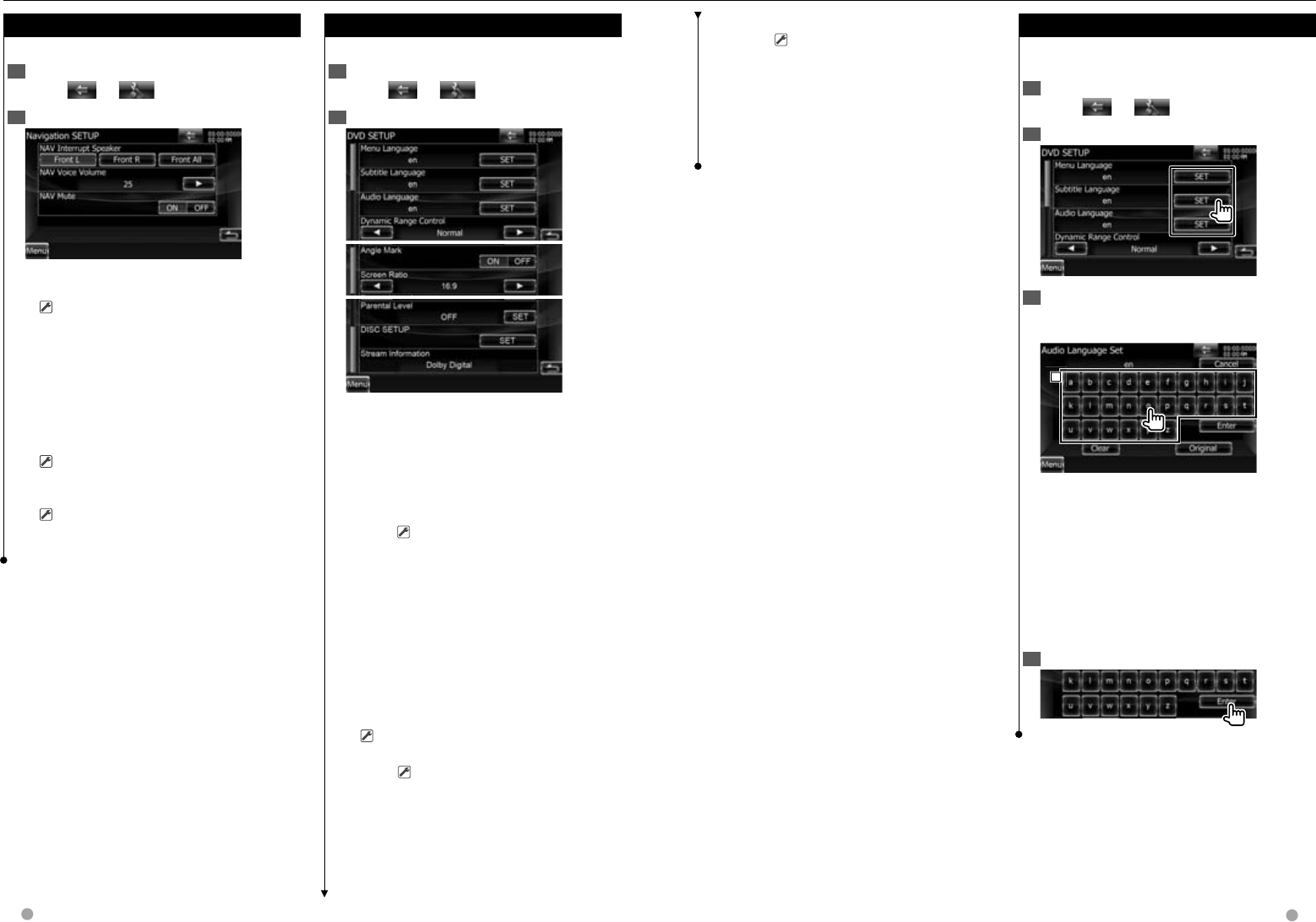
82 DNX9980HD English 83
Next page 3
[Parental Level]*1 Displays the Parental Lock
screen. ( "OFF")
See <DVD Parental Level Setup> (page 84).
[Disc SETUP] Makes the settings related to the
disc media. See <Disc Setup> (page 84).
[Stream Information]
⁄
• * Disabled when a DVD is being played.
DVD Language Setup
DVD Language Setup
Selects a language you use for the speech and
menus.
1 Display the DVD Setup screen
Touch [ ]
>
> [ ]
>
> [DVD SETUP]. (page 72)
2 Select the language item to set
3 Enter a language code
See <DVD Language Codes> (page 99) and select
the desired language.
1
1
1
1 Enters a language code.
[Cancel] Cancels the language setup and returns
to the "DVD SETUP" screen.
[Enter] Sets the language and returns to the
"DVD SETUP" screen. (It appears after you have
entered a language code.)
[Original] Sets the DVD's original language (only
when setting an audio language).
[Clear] Clears the language code.
4 Set the language you use
Setup Menu
Navigation Setup
Navigation Setup
You can set Navigation parameters.
1 Display the Navigation Setup screen
Touch [ ]
>
> [ ]
>
> [Navigation]. (page 72)
2 Set each item
[NAV Interrupt Speaker] Selects speakers used
for voice guidance of the navigation system.
( "Front All")
"Front L": Uses the front left side speaker for
voice guidance.
"Front R": Uses the front right side speaker for
voice guidance.
"Front All": Uses both front speakers for voice
guidance.
[NAV Voice Volume] Adjusts the volume for
voice guidance of the navigation system.
( "25")
[NAV Mute] Mutes the volume of rear speakers
during voice guidance of the navigation system.
( "ON")
When turned "ON", the volume level drops for
voice guidance.
DVD Setup
DVD Setup
You can set up the DVD play.
1 Display the DVD Setup screen
Touch [ ]
>
> [ ]
>
> [DVD SETUP]. (page 72)
2 Set each item
[Menu Language]*1 Selects a disc menu
language. See <DVD Language Setup> (page 83).
[Subtitle Language]*1 Selects a subtitle
language. See <DVD Language Setup> (page 83).
[Audio Language]*1 Selects an audio language.
See <DVD Language Setup> (page 83).
[Dynamic Range Control]*1 Sets the dynamic
range. ( "Dialog")
The dynamic range is reduced by changing
from "Wide" to "Normal" and from "Normal" to
"Dialog". "Dialog" makes the total sound volume
becomes larger as compared with "Wide" and
"Normal", allowing you to listen to the movie's
dialog more clearly.
This is effective only when you are using a Dolby
Digital software.
The operation is available during the play stop
mode.
[Angle Mark] Sets an angle mark display.
( "ON")
[Screen Ratio]*1 Selects the screen display
mode. ( "16:9")
"16:9": Displays wide pictures.
"4:3 LB": Displays wide pictures in the Letter Box
format (having black stripes at the top and
bottom of screen).
"4:3 PS": Displays wide pictures in the Pan &
Scan format (showing pictures cut at the right
and left ends).
DNX9980HD_K_English.indd 82-83 10/11/04 18:23
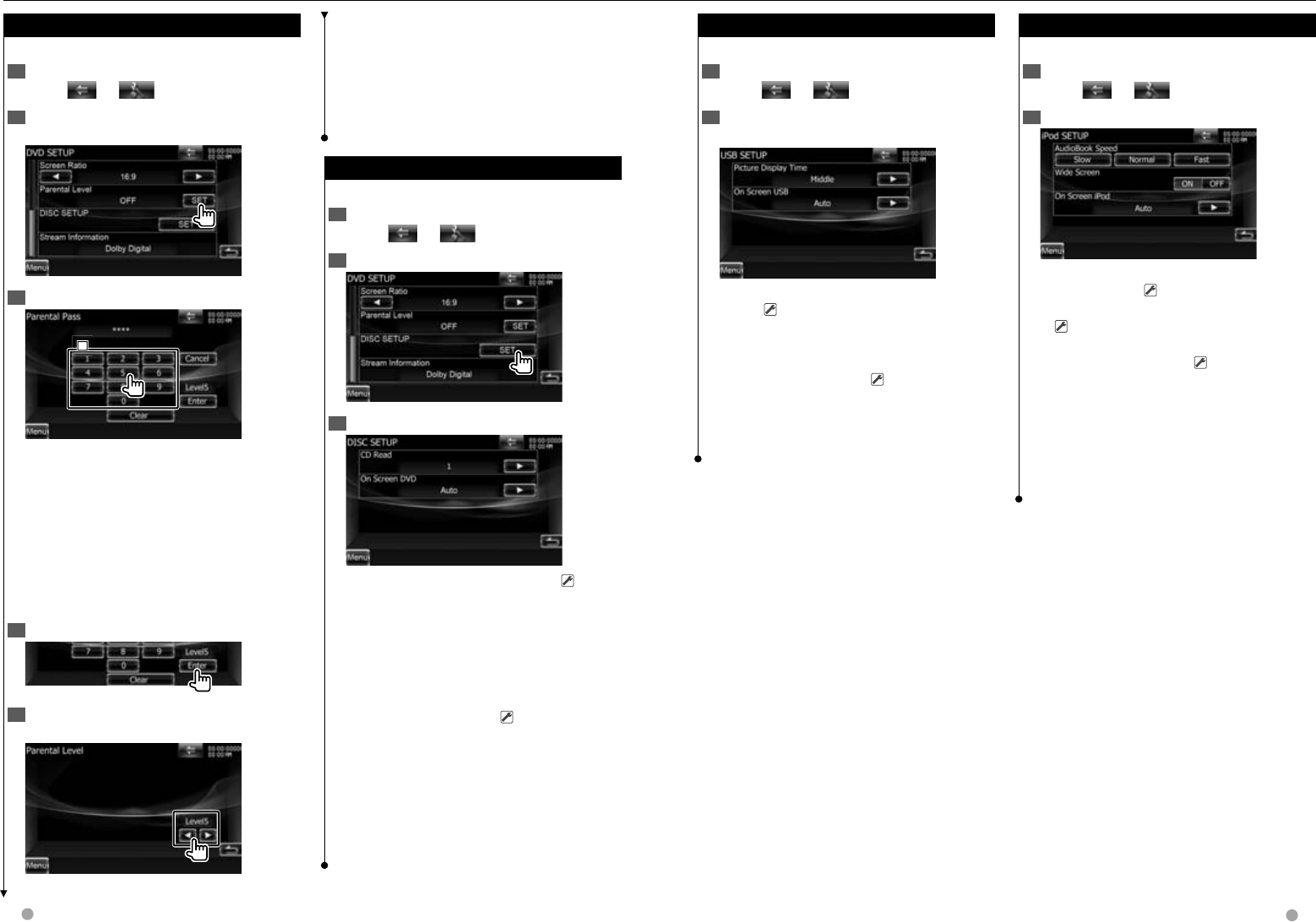
84 DNX9980HD English 85
Next page 3
USB Setup
USB Setup
Performs setup when using USB.
1 Display the USB Setup screen
Touch [ ]
>
> [ ]
>
> [USB SETUP]. (page 72)
2 Set each item
Example : USB Setup screen
[Picture Display Time] Selects a picture display
time. ( "Long")
The Display of a JPEG picture is changed. ("Short",
"Middle", "Long")
[On Screen USB] Sets an on-screen display of
the USB Playback screen. ( "Auto")
"Auto": Information is displayed for 5 seconds
when updated.
"OFF": Information is displayed when you touch
on the screen.
iPod Setup
iPod Setup
Performs setup when using iPod.
1 Display the iPod Setup screen
Touch [ ]
>
> [ ]
>
> [iPod SETUP]. (page 72)
2 Set each item
[AudioBook Speed] Sets the Audio book
playback speed. ( "Normal")
[Wide Screen] Sets Wide Screen on or off.
( "OFF")
[On Screen iPod] Sets an on-screen display of
the iPod Playback screen. ( "Auto")
"Auto": Information is displayed for 5 seconds
when updated.
"OFF": Information is displayed when you touch
on the screen.
⁄
• "Wide Screen" cannot be set while the iPod is
connected.
Setup Menu
DVD Parental Level Setup
DVD Parental Level Setup
Sets a parental level.
1 Display the DVD Setup screen
Touch [ ]
>
> [ ]
>
> [DVD SETUP]. (page 72)
2 Display the Parental Level code number
screen
3 Enter the code number
1
1
1
1 Enters a code number.
[Cancel] Cancels the current setup and returns to
the "DVD SETUP" screen.
[Level] Indicates the present parental lock level.
[Enter] Determines the code number and
displays the Parental Level setup screen.
[Clear] Clears the code number.
⁄
• The number you enter first is set as your code number.
4 Display the Parental Level SETUP screen
5 Select a parental level and complete the
setup
Selects a parental level.
⁄
• If a disc has higher parental lock level, you need to
enter the code number.
• The parental lock level varies depending on a loaded
disc.
• If a disc has no parental lock, anybody can play it back
even when you have set the parental lock.
Disc Setup
Disc Setup
Performs setup when using disc media.
1 Display the DVD Setup screen
Touch [ ]
>
> [ ]
>
> [DVD SETUP]. (page 72)
2 Display the Disc Setup screen
3 Set each item
[CD Read] Sets a music CD playback. ( "1")
"1": Automatically recognizes and plays back an
Audio file disc, a DVD or a music CD.
"2": Forcibly plays back a disc as a music CD.
Select "2" if you wish to play a music CD having
a special format or if you cannot play a disc in
the "1" position.
[On Screen DVD] Sets an on-screen display of
the DVD Playback screen. ( "OFF")
"Auto": Information is displayed for 5 seconds
when updated.
"OFF": Information is not displayed.
⁄
• [CD Read]
Disabled when a disc is in the unit.
You cannot play an Audio file/VCD disc in the "2" position.
Also, you may not play some music CDs in the "2" position.
DNX9980HD_K_English.indd 84-85 10/11/04 18:23
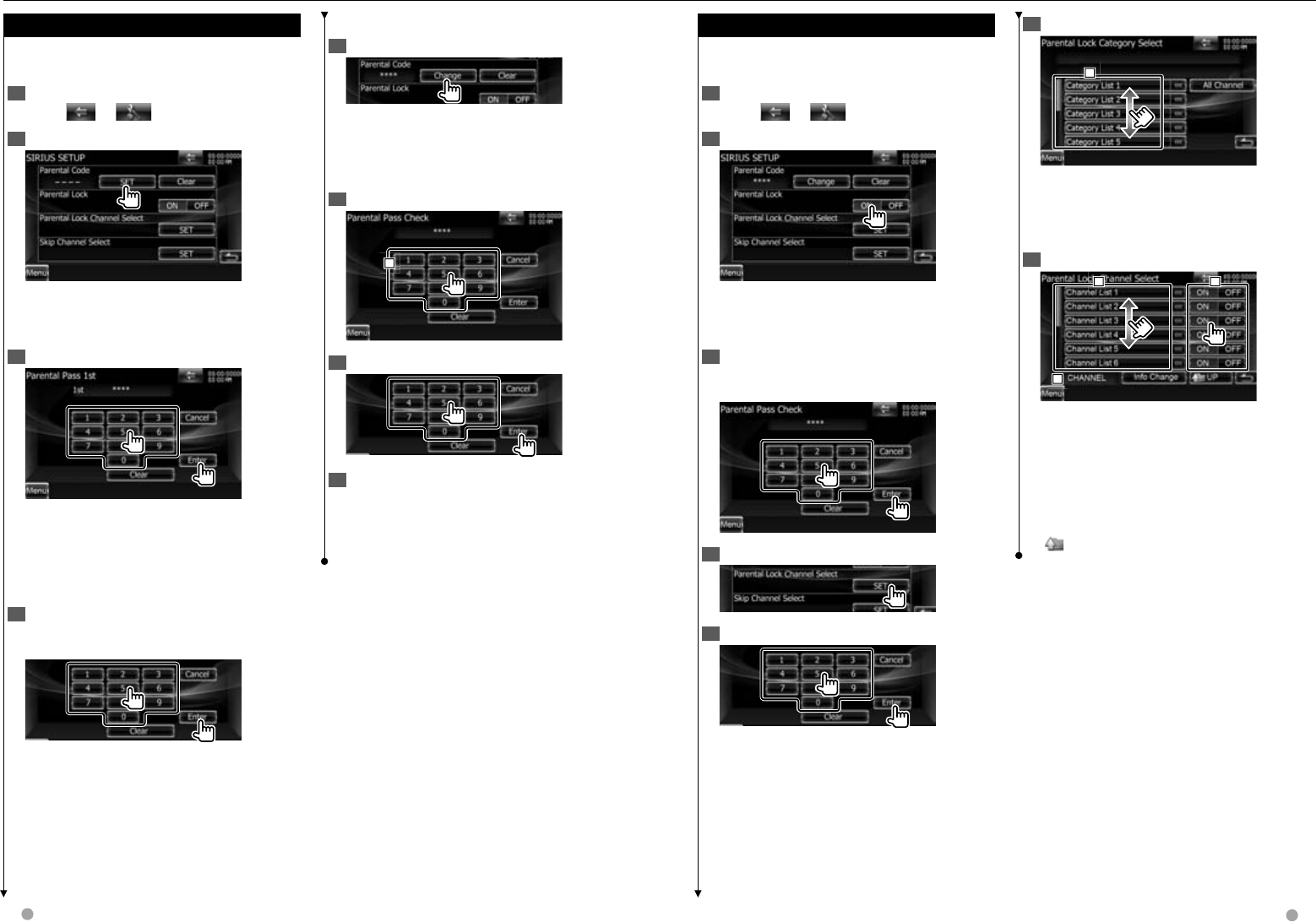
86 DNX9980HD English 87
Next page 3
SIRIUS Parental Lock Setup
SIRIUS Parental Lock Setup
Selects the channel to enable SIRIUS Parental lock
function.
1 Display the SIRIUS Setup screen
Touch [ ]
>
> [ ]
>
> [SIRIUS SETUP]. (page 72)
2 Display the Parental Code screen
⁄
• You need to complete <SIRIUS Parental Code Setup>
beforehand.
3 Enter the code number
Enter the same code number as you originally
input <SIRIUS Parental Code Setup> (page 86).
4 Display the Parental Code screen
5 Enter the code number
6 Select a category
1
1
1
1 Category list
Displays all the channels in the selected
category.
[All Channel] Displays all the channels.
7 Set the parental lock for each channel
3
3
3
1
1
1
2
2
2
1 Channel list
2 Sets the Parental lock function on or off for
each channel.
3 Selects a channel.
[Info Change] Switch the sequence of the
channel list. (Channel name, Song title, Artist
name, Composer name, and Category name)
[UP] Moves to SIRIUS Category Select screen.
Setup Menu
SIRIUS Parental Code Setup
SIRIUS Parental Code Setup
Sets a SIRIUS Parental code. (with the optional
accessory SIRIUS Tuner connected only)
1 Display the SIRIUS Setup screen
Touch [ ]
>
> [ ]
>
> [SIRIUS SETUP]. (page 72)
2 Display the Parental Code screen
⁄
• If you have already completed the code registration,
[Change] is displayed.
3 Enter the Parental Code number
1 Enters a code number.
[Cancel] Cancels the current setup and returns to
the SIRIUS Setup screen.
[Enter] Determines the code number.
[Clear] Clears the code number.
4 Confirm the code number
Enter the same code number as you input in step
3.
SIRIUS Parental code is now set, and the display
returns to SIRIUS Setup screen.
Change the Parental Code
1 Display the Parental Code screen
[Clear] Clears the Parental Code.
⁄
• Pressing [Clear] for 5 seconds or longer deletes the
code.
2 Enter the current code number
1
1
1
3 Enter the new code number
4 Confirm the code number
Enter the same code number as you input in step
3.
SIRIUS Parental code is now set, and the display
returns to SIRIUS Setup screen.
DNX9980HD_K_English.indd 86-87 10/11/04 18:23
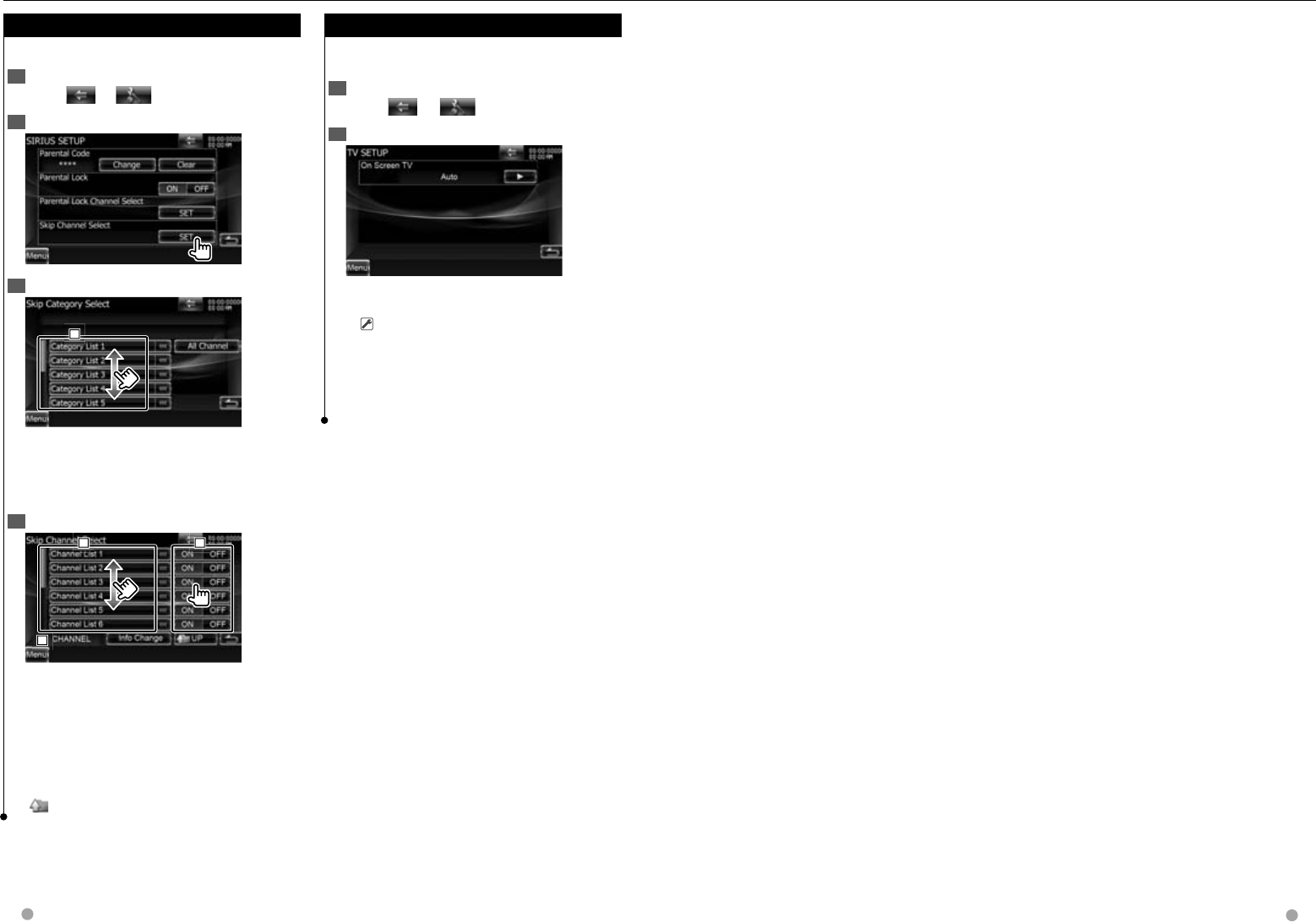
88 DNX9980HD English 89
Setup Menu
SIRIUS Skip Channel Select
SIRIUS Skip Channel Select
Sets the undesired channels unselected.
1 Display the SIRIUS Setup screen
Touch [ ]
>
> [ ]
>
> [SIRIUS SETUP]. (page 72)
2 Display the Skip Category Select screen
3 Select a category
1
1
1
1 Category list
Displays all the channels in the selected
category.
[All Channel] Displays all the channels.
4 Set the skip for each channel
3
3
3
1
1
1
2
2
2
1 Channel list
2 Sets the skip function on or off for each
channel.
3 Selects a channel
[Info Change] Switch the sequence of the
channel list. (Channel name, Song title, Artist
name, Composer name, and Category name)
[UP] Moves to SIRIUS Category Select screen.
TV Setup
TV Setup
The TV signal receiving areas can be set. (with the
optional accessory TV Tuner connected only)
1 Display the TV SETUP screen
Touch [ ]
>
> [ ]
>
> [TV SETUP]. (page 72)
2 Set each item
[On Screen TV] Sets an on-screen display of the
TV screen.
( "Auto") (with the optional accessory TV tuner
connected only)
"Auto": Information is displayed for 5 seconds
when updated.
"OFF": Information is displayed when you touch
on the screen.
DNX9980HD_K_English.indd 88-89 10/11/04 18:23
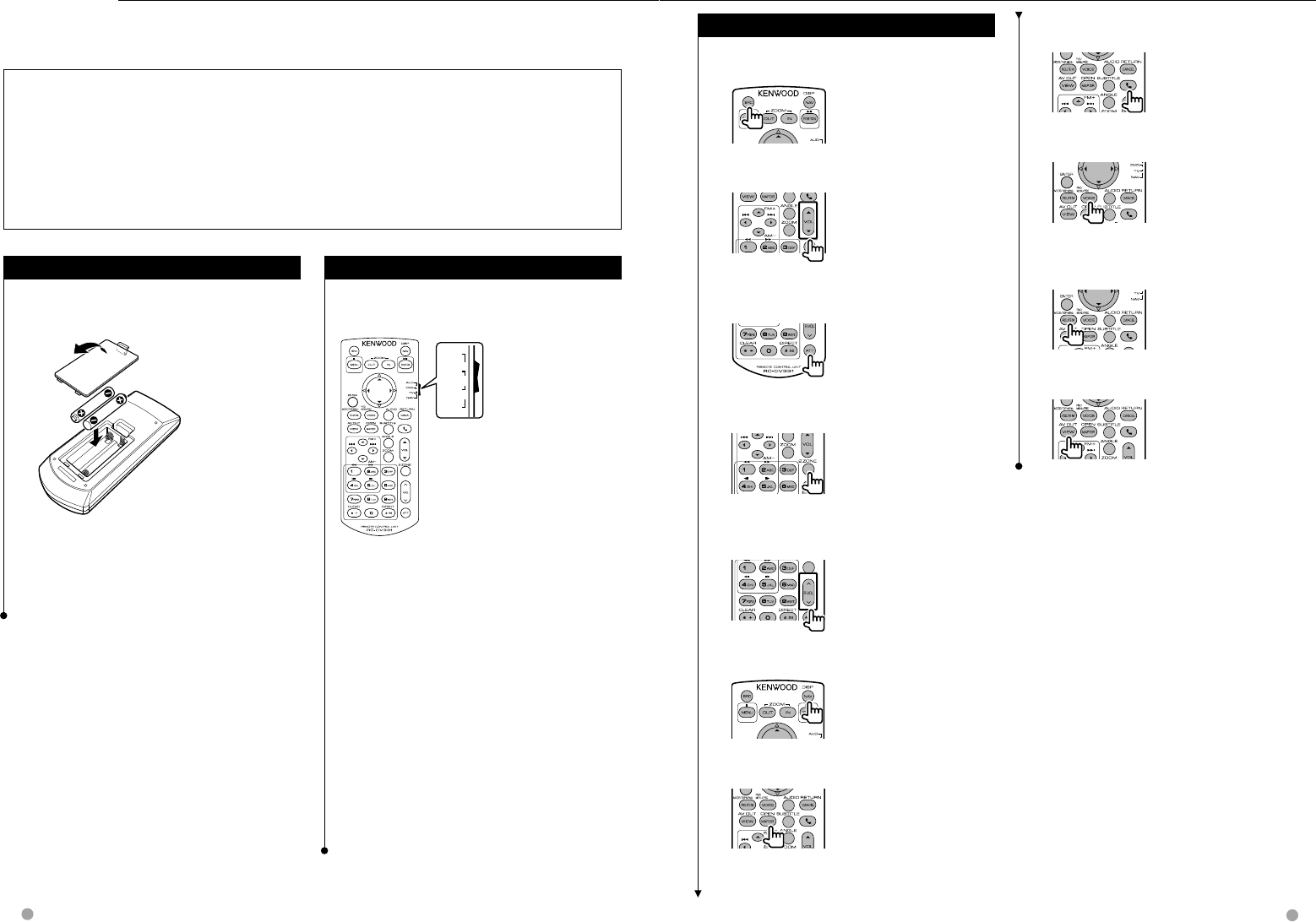
90 DNX9980HD English 91
Next page 3
Remote Controller
This unit can be operated using the Remote Controller supplied with this unit.
Battery installation
Battery installation
Use two "AAA"/"R03"-size batteries.
Insert the batteries with the + and – poles aligned
properly, following the illustration inside the case.
⁄
• If the Remote Controller operates only over shorter
distances or does not operate at all, it is possible that
the batteries are depleted. In such instances, replace
the both batteries with new ones.
Remote Controller mode switch
Remote Controller mode switch
The functions operated from the remote controller
differ depending on the position of the mode
switch.
DVD
TV
NAV
AUD
U
U
U
U
AUD mode
Switch to this mode when controlling a selected
source or tuner source, etc.
DVD mode
Switch to this mode when playing DVDs or CDs etc.
with the player integrated in this unit.
TV mode
Switch to this mode when controlling TV.
NAV mode
Switch to this mode when controlling Navigation
unit.
⁄
• The position of the remote control mode switch is
indicated in the title of each mode, e.g., "(AUD mode)".
• When controlling a player that is not integrated in the
unit, select "AUD" mode.
¤ CAUTION
• Put the Remote Controller in a place where it will not move during braking or other operations. A dangerous
situation could result, if the Remote Controller falls down and gets wedged under the pedals while driving.
• Do not leave the battery near fire or under direct sunlight. A fire, explosion or excessive heat generation may result.
• Do not recharge, short, break up or heat the battery or place it in an open fire. Such actions may cause the battery to
leak fluid. If spilled fluid comes in contact with your eyes or on clothing, immediately rinse with water and consult a
physician.
• Place the battery out of reach of children. In the unlikely event that a child swallows the battery, immediately consult
a physician.
Common operations (AUD mode)
Common operations (AUD mode)
Source switching
Switches to the source to be played.
Volume control
Adjusts the volume.
Volume attenuator
Press the key once to lower the volume. Press again
to restore the previous volume.
Dual Zone
Switches the Dual Zone function ON and OFF.
Rear volume control
Adjusts volume at rear when the Dual Zone function
is ON.
V.SEL
Switches to the navigation screen.
Display angle
Switches the display angle each time it is pressed.
Hands-free communication
When a call comes in, it answers the call.
Function
Switches the function screen.
MODE
Switches the screen mode.
Screen mode changes each time you press this key.
AV Output
Selects an AV source to be output.
DNX9980HD_K_English.indd 90-91 10/11/04 18:23
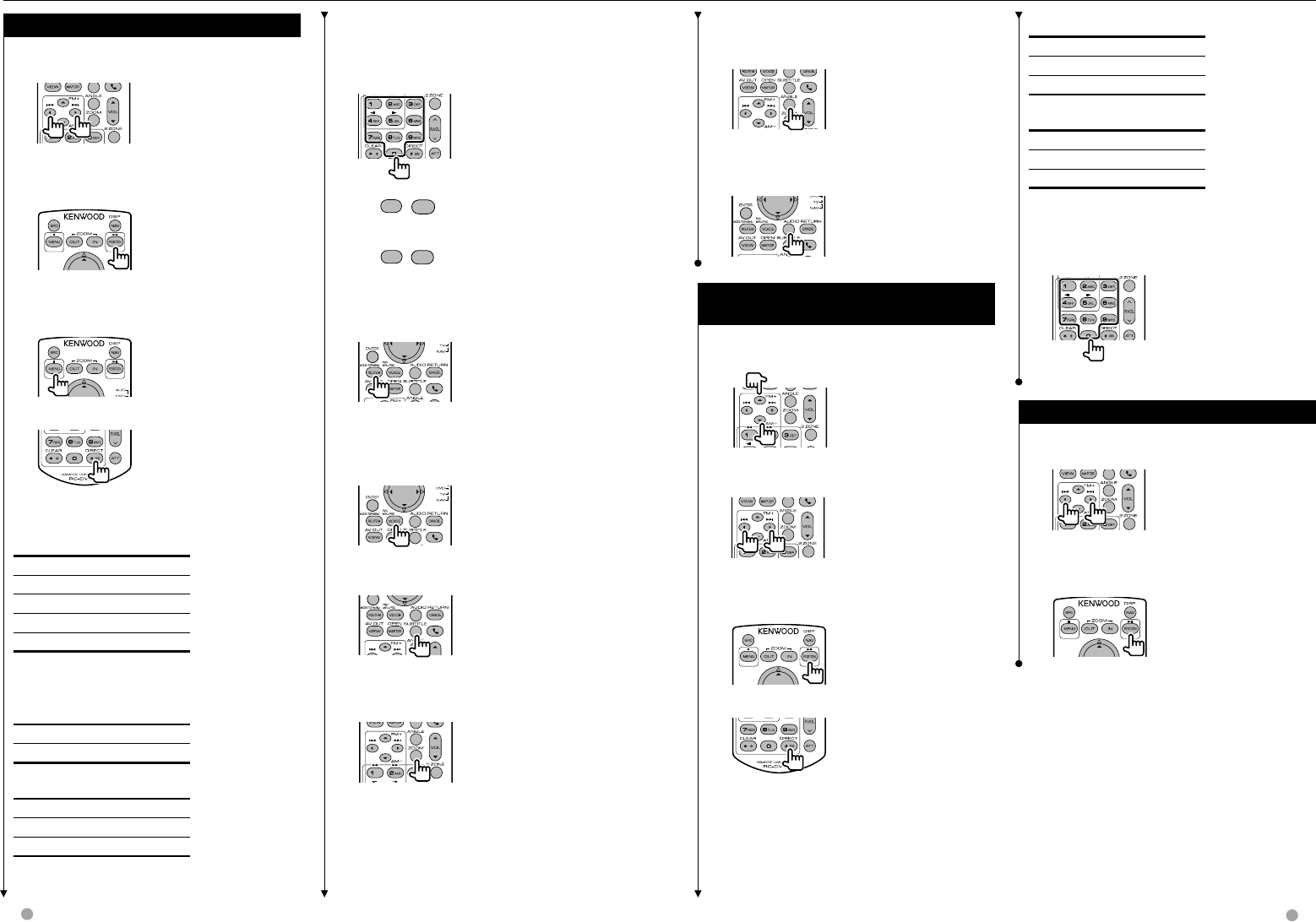
92 DNX9980HD English 93
Next page 3
Picture Angle
Switches the picture angle each time you press this
key.
AUDIO
Switches the voice language each time you press
this key.
Music CD/Audio file/Video file/ Picture file
Music CD/Audio file/Video file/ Picture file
(AUD mode)
(AUD mode)
Folder search
Selects the folder to be played.
Track search and file search
Selects the track or file to be played.
Play/Pause
Pauses the track or file.
Press again to resume playing.
Direct search
Pressing this key switches the features that can be
searched directly.
Music CD
Track number
Play time
Cancel
Audio files in DVD/CD disc
Folder number
File number
Cancel
Once you have switched to the direct search feature,
specify the search number from the numeric keypad,
and then press [38] key.
Numeric keypad
• Specify the number to search in direct search.
iPod (AUD mode)
iPod (AUD mode)
Music/Video search
Selects the music/video to be played.
Play/Pause
Pauses the music/video.
Press again to resume playing.
Remote Controller
Once you have switched to the direct search feature,
specify the search number from the numeric keypad,
and then press [ENTER] key.
Numeric keypad
• Specify the number to search in direct search.
• Press
1
2
ABC
to fast forward/backward.
Switches the fast forward/backward speed each
time you press this key.
• Press
4GHI
5JKL
to slow forward/backward.
Switches the slow playback speed each time you
press this key.
DVD Top Menu
Returns to the DVD top menu.
DVD Menu
Displays the DVD menu.
Turns the playback control on or off while playing
VCD.
SUBTITLE
Switches the subtitle language.
ZOOM
Switches the zoom ratio each time you press this
key.
DVD/VCD (DVD mode)
DVD/VCD (DVD mode)
Track search and file search
Selects the track or file to be played.
Play/Pause
Pauses the track.
Press again to resume playing.
Stop
Memorizes the last point where the disc stopped.
When pressed again, the last point is deleted.
Direct search
Pressing this key switches the features that can be
searched directly.
DVD-VIDEO
Title number
Chapter number
Play time
Item number*
Cancel
* You may not be able to use this function with some
discs or scenes.
VCD 1.X, VCD 2.X (PBC OFF)
Track number
Cancel
VCD 2.X (PBC ON)
Scene number
Number
Cancel
DNX9980HD_K_English.indd 92-93 10/11/04 18:23
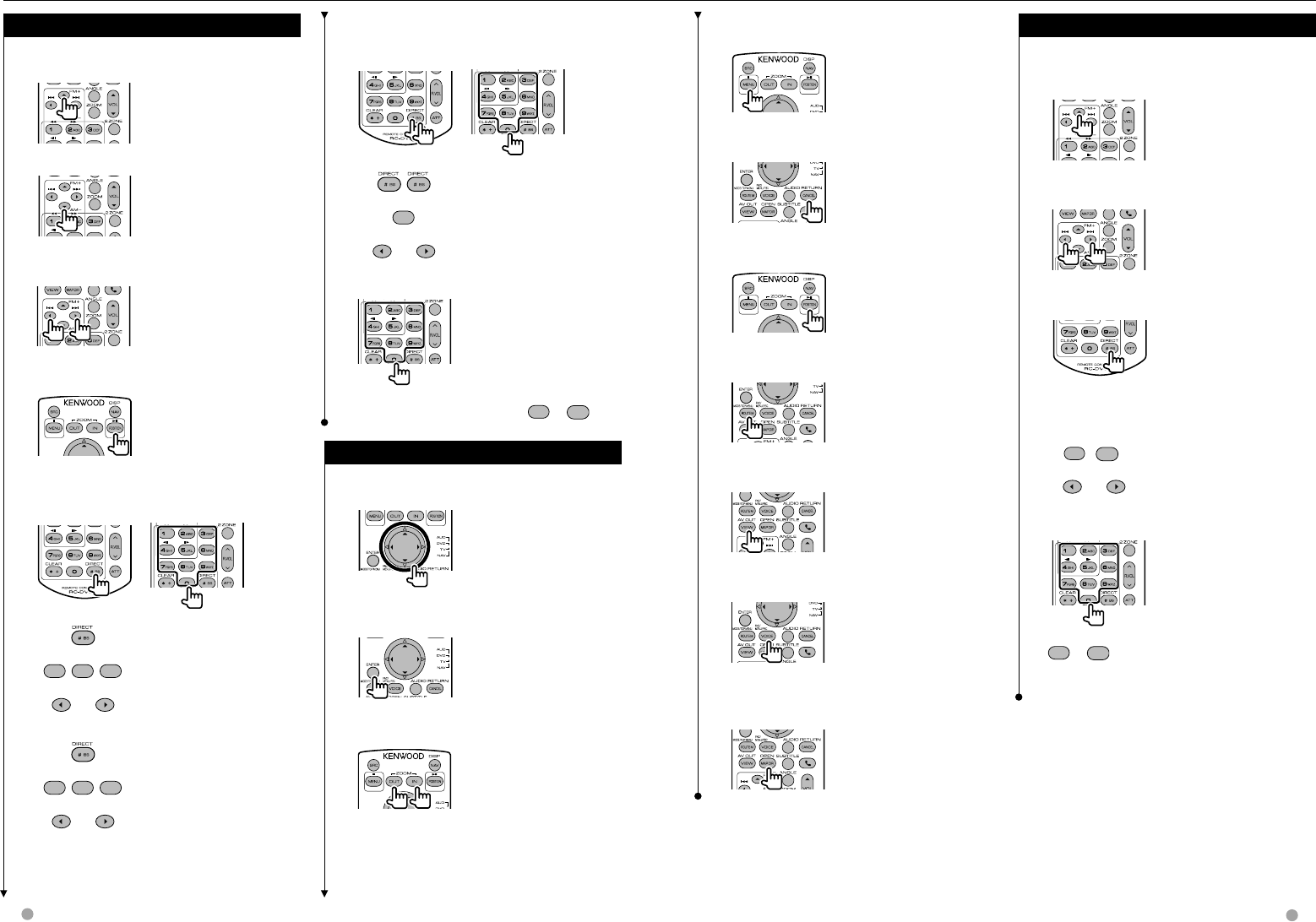
94 DNX9980HD English 95
Remote Controller
Direct channel search
After pressing this key, use the keypad to specify the
channel you wish to receive.
\
Example: 2 channel
«
2ABC
«
or
Numeric keypad
• To use preset tuning, press the number of a
programmed broadcast station. (
1
–
6
MNO )
Navigation (NAV mode)
Navigation (NAV mode)
Cursor key
Scrolls the map, or moves the cursor.
ENTER
Performs the selected function.
ZOOM
Zooms in or out the navigation map.
HD Radio (AUD mode)
HD Radio (AUD mode)
FM band switching
Switches to bands received by the unit.
AM band
Station selection
Switches to broadcast stations received by the unit.
Seek mode switching
Switches the Seek mode (AUTO1, AUTO2, MANU).
Direct tuning
After pressing this keypad, use the key to specify the
broadcast station you wish to receive.
\
Example: 92.1MHz (FM)
«
9
WXYZ
2ABC
1
«
or
Example: 810kHz (AM)
«
8TUV
1
0
«
or
MENU
Displays Main menu.
CANCEL
Displays previous screen.
POSITION
Displays the current position.
ROUTE M
Displays Route Option menu.
VIEW
Switches between 2D and 3D map displays.
VOICE
Plays Voice guidance.
MAP DIR
Switches between the heading up navigation and
north up navigation map displays.
TV (TV mode)
TV (TV mode)
Switching Band/Video
It switches between the station of the TV band to
receive and video input.
Channel Selection
The TV channel to receive is selected.
Direct tuning
(NTSC TV type only)
Press this key first, and then specify the station to
receive with the numeric keypad.
Example: In case of Channel 6 (2-digit)
0
6
MNO
«
or
Numeric keypad
• The number of the memorized station is selected.
(
1
–
6
MNO )
• Press the direct tuning key first, then specify the
channel of the station to receive.
DNX9980HD_K_English.indd 94-95 10/11/04 18:23
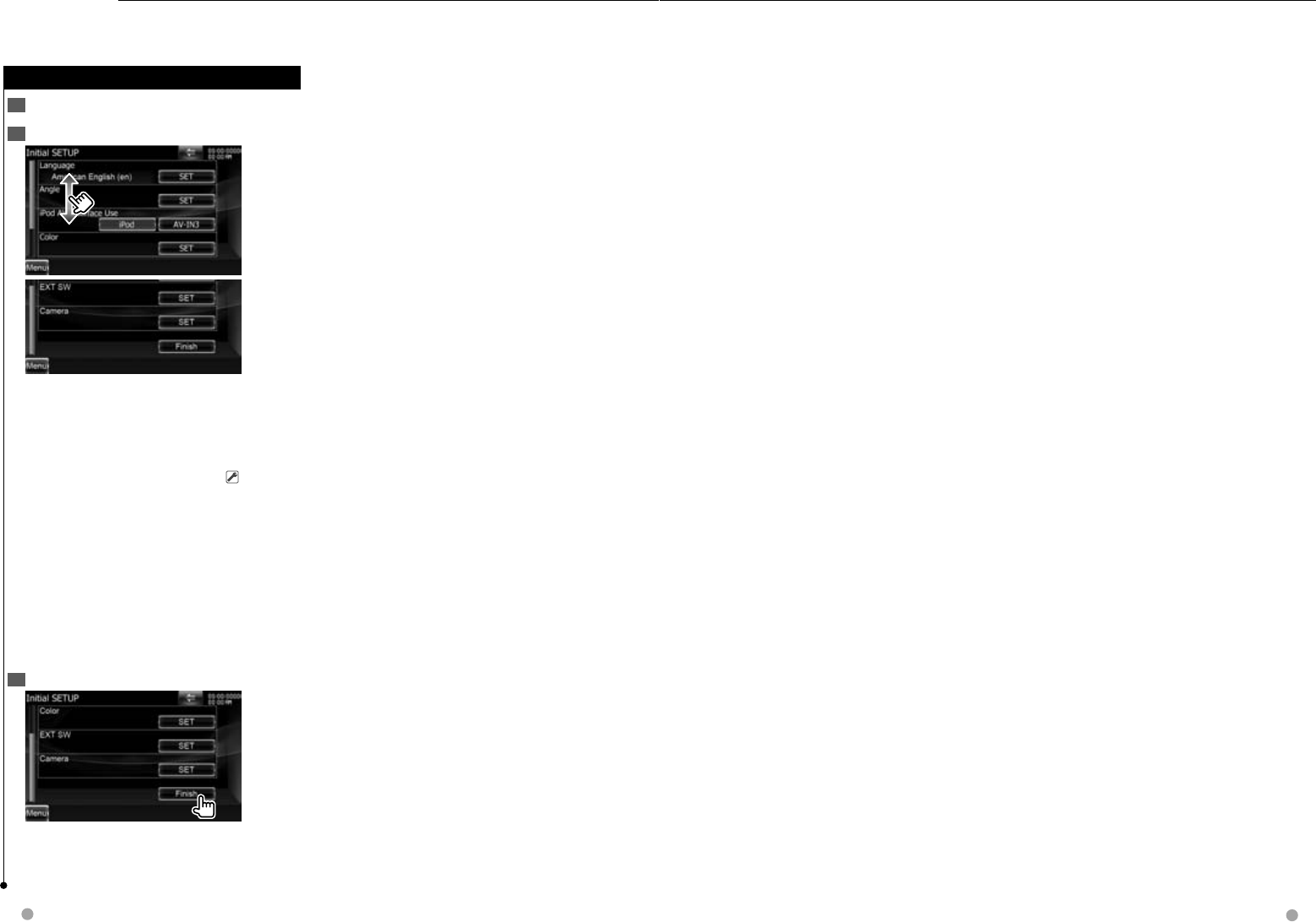
96 DNX9980HD English 97
Initial Setup
Initial Setup
1 Turns the power On
2 Set each item
[Language] Select the language used for the
control screen and setting items. (page 74)
[Angle] You can adjust the position of the
monitor. (page 76)
[iPod AV Interface Use] You can determine the
use of iPod/AV-IN3 input terminal. ( "iPod")
"iPod": Select when connecting the iPod using
the KCA-iP302 for iPod.
"AV-IN3": Select to play an AV component
connected to the iPod/AV-IN3 input terminal.
[Color] Sets the button illumination color. (page
79)
[EXT SW] Set the controls for the external
devices. (page 76)
[Camera] Set the parameters for the Camera. See
<Camera Setup> (page 81).
3 End initial setup
⁄
• The settings above can be changed in <Setup Menu>
(page 72).
When pressing the Reset button or turning on the unit for the first time, the Initial SETUP screen is displayed.
Initial Setup
DNX9980HD_K_English.indd 96-97 10/11/04 18:23
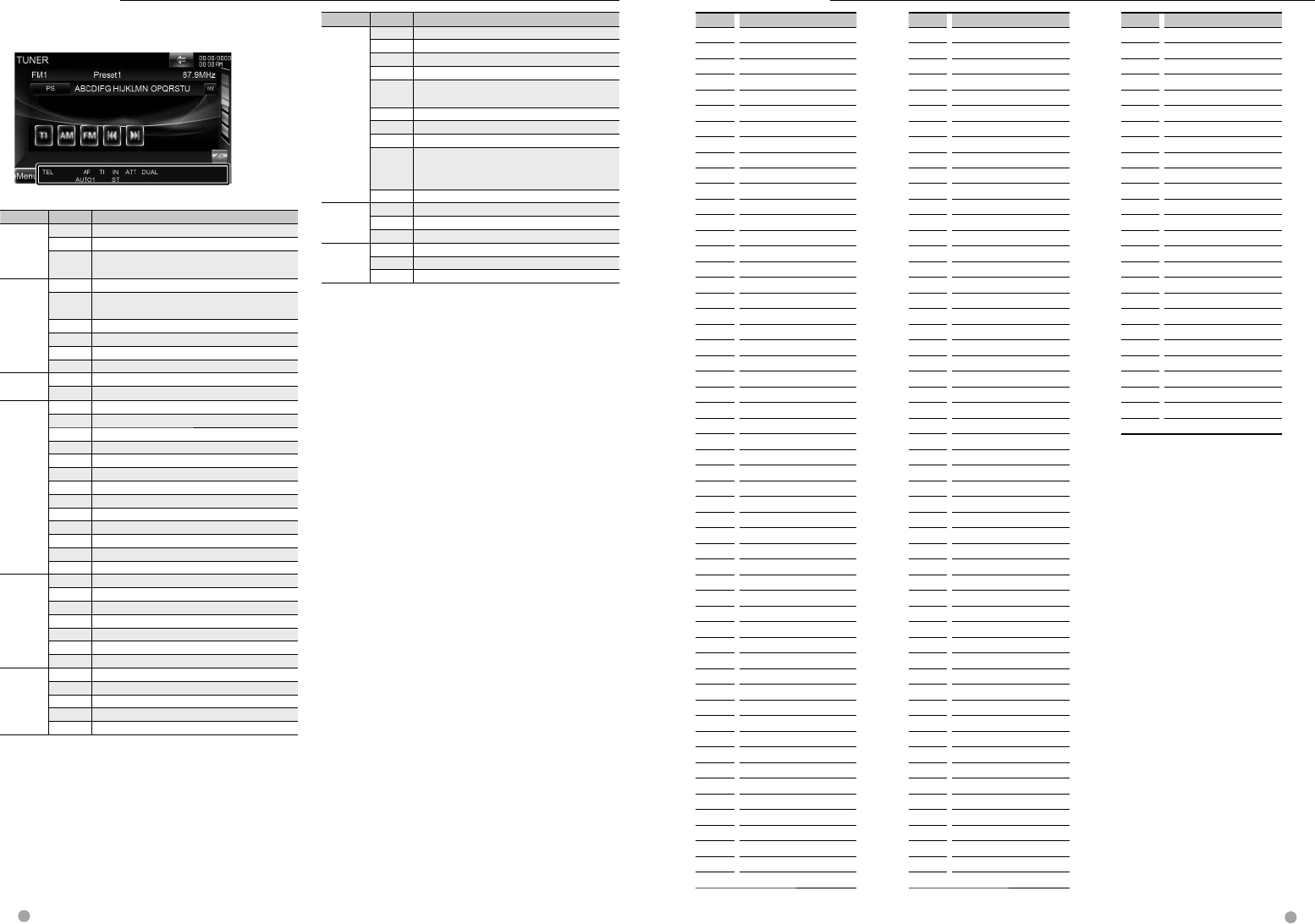
98 DNX9980HD English 99
Source Display Overview
HD Radio "AUTO1" Indicates that Seek mode is set to Auto1.
"AUTO2" Indicates that Seek mode is set to Auto2.
"MANU" Indicates that Seek mode is set to Manual.
"HD" Indicates that HD Radio station is being received.
"M/S" Indicates whether the reception channel is main or sub.
(Orange: Sub channel White: Main channel)
"ANALOG" Indicates that analog broadcast is being received.
"DIGITAL" Indicates that digital broadcast is being received.
"ST" Indicates that stereo broadcast is being received.
"TI" Indicates the reception state of traffic information.
(Orange: TP is being received. White: TP is not being
received.)
"TAG" Indicates that Tagging is enabled.
SIRIUS/ XM "SCN" Indicates that the channel scan function is ON.
"SEEK1" Indicates that Seek mode is set to 1.
"SEEK2" Indicates that Seek mode is set to 2.
TV "AUTO1" Indicates that Seek mode is set to Auto1.
"AUTO2" Indicates that Seek mode is set to Auto2.
"MANU" Indicates that Seek mode is set to Manual.
Shown below is a list of indicators displayed on the
Status bar.
Source Display Overview
General "ATT" Indicates that the attenuator is active.
"DUAL" Turns on the Dual zone function.
"TEL" Indicates the connection state of the Bluetooth hands-
free unit. (White: Connected. Orange: Not connected.)
DVD/CD "FO-REP" Indicates that the Folder repeat function is ON.
"IN" Indicates that a disc is inserted. (White: A Disc is inside
the unit. Orange: Error at the disc player.)
"VIDEO" Identifies the video file.
"MUSIC" Identifies the music file.
"RDM" Indicates that the Random function is ON.
"REP" Indicates that the Repeat function is ON.
DVD-Video "C-REP" Indicates that the Chapter repeat function is ON.
"T-REP" Indicates that the Title repeat function is ON.
VCD "1chLL" Identifies the left audio output of channel 1.
"1chLR" Identifies the monaural audio output of channel 1.
"1chRR" Identifies the right audio output of channel 1.
"1chST" Identifies the stereo audio output of channel 1.
"LL" Identifies the left audio output.
"LR" Identifies the monaural audio output.
"RR" Identifies the right audio output.
"ST" Identifies the stereo audio output.
"PBC" Indicates that the PBC function is ON.
"SVCD" Identifies the Super Video CD.
"VER1" Indicates that the Video CD version is 1.
"VER2" Indicates that the Video CD version is 2.
"REP" Indicates that the Repeat function is ON.
USB "FO-REP" Indicates that the Folder repeat function is ON.
"VIDEO" Identifies the video file.
"MUSIC" Identifies the music file.
"PICTURE" Identifies the image file.
"RDM" Indicates that the Random function is ON.
"REP" Identifies that the Repeat function is ON.
"PLST" Indicates that the Play list mode is selected now.
iPod "MUSIC" Identifies the music file.
"VIDEO" Identifies the video file.
"RDM" Indicates that the Random function is ON.
"A-RDM" Indicates that the Album random function is ON.
"REP" Indicates that the Repeat function is ON.
Status bar Indicator items DVD Language Codes
Code Language
aa Afar
ab Abkhazian
af Afrikaans
am Amharic
ar Arabic
as Assamese
ay Aymara
az Azerbaijani
ba Bashkir
be Byelorussian
bg Bulgarian
bh Bihari
bi Bislama
bn Bengali, Bangla
bo Tibetan
br Breton
ca Catalan
co Corsican
cs Czech
cy Welsh
da Danish
de German
dz Bhutani
el Greek
en English
eo Esperanto
es Spanish
et Estonian
eu Basque
fa Persian
fi Finnish
fj Fiji
fo Faroese
fr French
fy Frisian
ga Irish
gd Scots Gaelic
gl Galician
gn Guarani
gu Gujarati
ha Hausa
he Hebrew
hi Hindi
hr Croatian
hu Hungarian
hy Armenian
ia Interlingua
ie Interlingue
ik Inupiak
id Indonesian
is Icelandic
it Italian
ja Japanese
jv Javanese
ka Georgian
Code Language
kk Kazakh
kl Greenlandic
km Cambodian
kn Kannada
ko Korean
ks Kashmiri
ku Kurdish
ky Kirghiz
la Latin
lb Luxembourgish
ln Lingala
lo Laotian
lt Lithuanian
lv Latvian, Lettish
mg Malagasy
mi Maori
mk Macedonian
ml Malayalam
mn Mongolian
mo Moldavian
mr Marathi
ms Malay
mt Maltese
my Burmese
na Nauru
ne Nepali
nl Dutch
no Norwegian
oc Occitan
om (Afan) Oromo
or Oriya
pa Punjabi
pl Polish
ps Pashto, Pushto
pt Portuguese
qu Quechua
rm Rhaeto-Romance
rn Kirundi
ro Romanian
ru Russian
rw Kinyarwanda
sa Sanskrit
sd Sindhi
sg Sangho
sh Serbo-Croatian
si Singhalese
sk Slovak
sl Slovenian
sm Samoan
sn Shona
so Somali
sq Albanian
sr Serbian
ss Siswati
st Sesotho
Code Language
su Sundanese
sv Swedish
sw Swahili
ta Tamil
te Telugu
tg Tajik
th Thai
ti Tigrinya
tk Turkmen
tl Tagalog
tn Setswana
to Tongan
tr Turkish
ts Tsonga
tt Tatar
tw Twi
uk Ukrainian
ur Urdu
uz Uzbek
vi Vietnamese
vo Volapuk
wo Wolof
xh Xhosa
yo Yoruba
zh Chinese
zu Zulu
DNX9980HD_K_English.indd 98-99 10/11/04 18:23
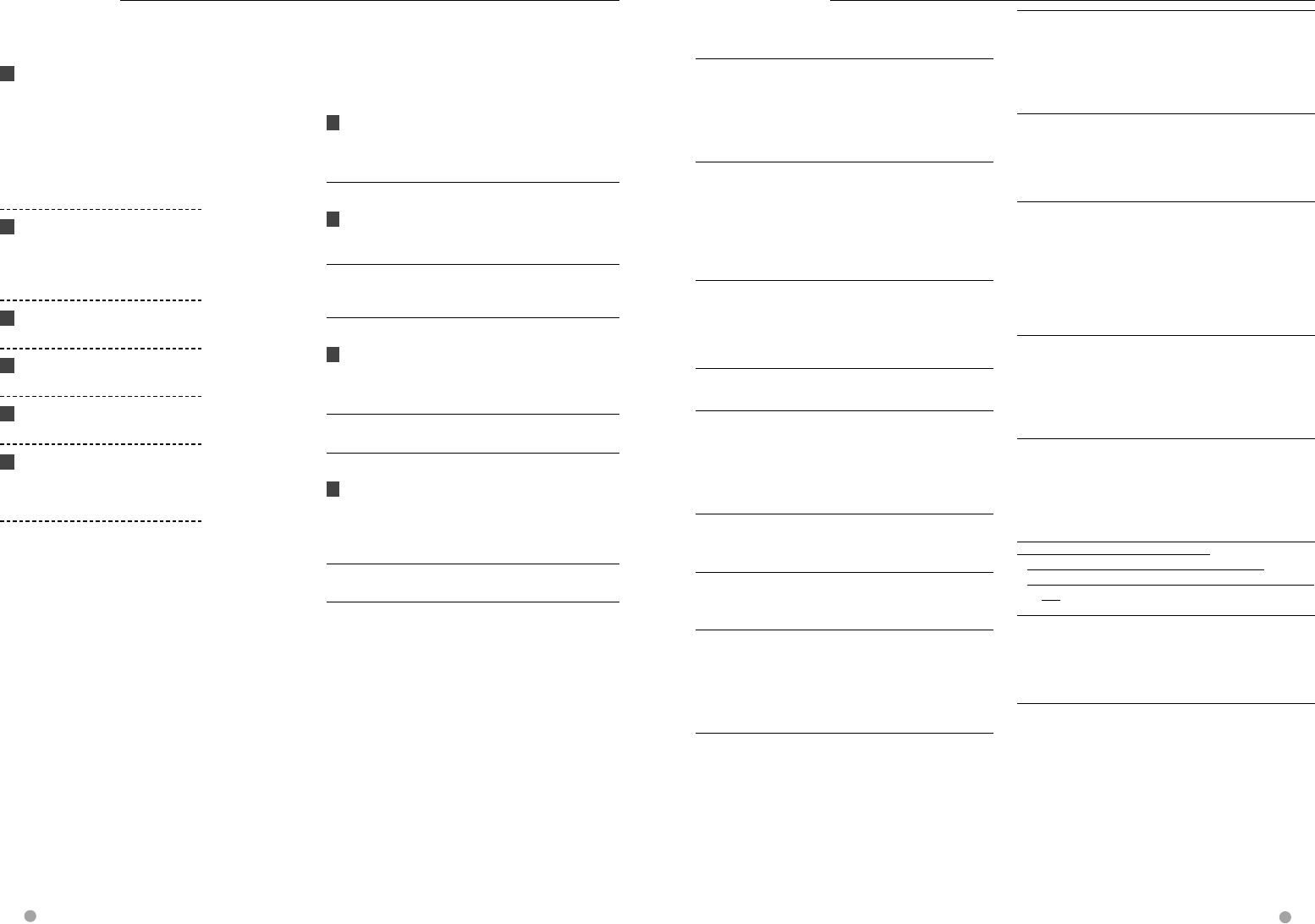
100 DNX9980HD English 101
Next page 3
Help? Troubleshooting
Some functions of this unit may be disabled by
some settings made on this unit.
! • Cannot set up the subwoofer.
• Cannot set up subwoofer phase.
• No output from the subwoofer.
• Cannot set up the low pass filter.
• Cannot set up the high pass filter.
▲
Subwoofer is not set to On.
☞ <Speaker Setup> (page 69)
▲
The Dual zone function is enabled.
☞ <Zone Control> (page 67)
! • Cannot select the output destination of the
subsource in the Dual zone.
• Cannot adjust the volume of the rear speakers.
▲
The Dual zone function is disabled.
☞ <Zone Control> (page 67)
! Cannot play audio files.
▲
"CD Read" of <Disc Setup> (page 84) is set to "2".
! Cannot Folder select.
▲
The Random play function is enabled.
! Cannot perform Repeat play.
▲
The PBC function of the Video CD is enabled.
! • Cannot set up the equalizer.
• Cannot set up the crossover network.
▲
The Dual zone function is enabled.
☞ <Zone Control> (page 67)
What might seem to be a malfunction in your unit
may just be the result of slight misoperation or
miswiring. Before calling service, first check the
following table for possible problems.
General
? The Touch Sensor Tone doesn’t sound.
✔ The preout jack is being used.
☞ The Touch Sensor Tone can’t be output from the
preout jack.
Tuner source
? Radio reception is poor.
✔ The car antenna is not extended.
☞ Pull the antenna out all the way.
✔ The antenna control wire is not connected.
☞ Connect the wire correctly, referring to the section on
<INSTALLATION MANUAL>.
Disc source
? The specified disc does not play, but another one
plays instead.
✔ The specified CD is quite dirty.
☞ Clean the CD.
✔ The disc is severely scratched.
☞ Try another disc instead.
Audio file source
? The sound skips when an Audio file is being
played.
✔ The media is scratched or dirty.
☞ Clean the media, referring to the CD cleaning of the
section on <Handling discs> (page 4).
✔ The recording condition is bad.
☞ Record the media again or use another media.
Help? Error
When the unit fails to operate correctly, the
cause of the failure appears on the display.
"Protect" :
Protective circuit has been activated because a speaker
cord has shorted or it has come in contact with the car
chassis.
➡ Wire or insulate the speaker cord as appropriate and
then push the Reset button.
"Hot Error" :
When the internal temperature of this unit rises to 60°C
or more, the protection circuit is activated and you
may not be able to operate the unit. At such times this
message will appear.
➡ Use the unit again after reducing the temperature
inside the vehicle.
"Mecha Error" :
The disc player is malfunctioning.
➡ Eject the disc and try inserting it again. Contact the
Kenwood dealer if this indicator continues blinking or
the disc cannot be ejected.
"Disc Error" :
An unplayable disc is inserted.
"Read Error" :
Disc is quite dirty.
➡ Clean the disc, referring tot he section on <Handling
discs> (page 4).
Disc is upside down.
➡ Load the disc with the labeled side up.
"Region code Error" :
The disc you wanted to play has a region code that
cannot be played with this unit.
"Parental level Error" :
The disc you wanted to play has a higher level than the
parental level you set.
"Error 07–67" :
The unit is not operating correctly due to some reason
or other.
➡ Push the unit's Reset button. If the "Error 07−67"
message does not disappear, see your nearest
Kenwood dealer.
"No Device" (USB device):
The USB device is selected as a source although no USB
device is connected.
➡ Change the source to any source other than USB/
iPod. Connect an USB device, and change the source
to USB again.
"Disconnected" (iPod, Bluetooth audio player):
The iPod/Bluetooth audio player is selected as a source
although no iPod/Bluetooth audio player is connected.
➡ Change the source to any source other than iPod/
Bluetooth. Connect an iPod/Bluetooth audio player,
and change the source to iPod/Bluetooth again.
"No Music" :
The connected USB device contains no playable audio
file.
Media was played that doesn’t have data recorded that
the unit can play.
"USB Device Error!!" :
The connected USB device is rated a current capacity
higher than the allowable limit.
➡ Check the USB device.
Some trouble may have occurred to the connected USB
device.
➡ Change the source to any source other than USB.
Remove the USB device.
"Authorization Error" :
Connection to the iPod has failed.
➡ Remove the iPod and then reconnect it.
The unit does not support the iPod.
➡ Refer to <iPod/iPhone that can be connected to this
unit> (page 7).
"Update your iPod" :
The iPod's software is an older version which the unit
can not support.
➡ Confirm that the software for the iPod is the latest
version. Refer to <iPod/iPhone that can be connected
to this unit> (page 7).
"You only can connect one iPod." :
More than one iPod are connected to this unit.
➡ Connect only one iPod to the USB terminal with iPod
tag.
"Update your USB database" :
The USB device is different from the previous one or the
contained audio files are replaced.
➡ Update your database. Refer to <Source Control
Screen> (page 24) of USB Device Control.
"Navigation Error. Please turn on power again later."
:
The communication error has occurred due to severely
cold temperature.
➡ Turn on power again after warming your car interior.
DNX9980HD_K_English.indd 100-101 10/11/04 18:23
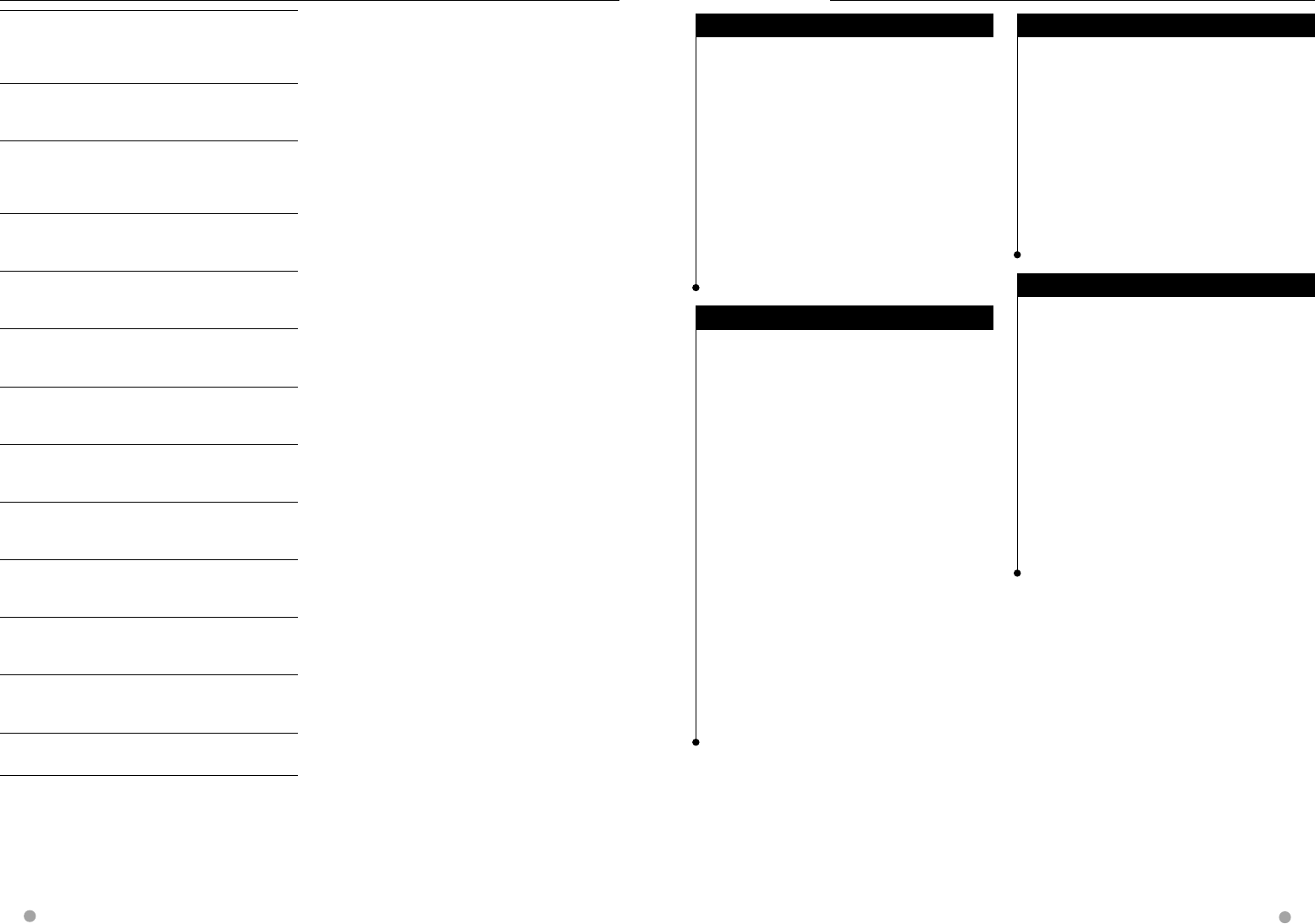
102 DNX9980HD English 103
Next page 3
"CHECK SIRIUS" :
The unit cannot recognize the connected SIRIUS Tuner
Box.
➡ Check the connection of the SIRIUS Tuner Box.
"ANTENNA ERROR" :
Something is wrong with the antenna.
➡ Check the connection of the antenna.
"ACQUIRING SIGNAL" :
The unit cannot receive any signal.
➡ Move the vehicle to the area where the unit can
receive signal.
"FIRMWARE UPDATING" :
Updating the firmware of SIRIUS tuner.
➡ Operation is invalid until the update is completed.
"CHANNELS UPDATING **% COMPLETE" :
Updating the SIRIUS Channel Map.
➡ Operation is invalid until the update is completed.
"SUBSCRIPTION UPDATED" :
Updating the subscription information.
➡ Operation is invalid until the update is completed.
"INVALID CHANNEL" :
The selected channel is invalid.
➡ Select a different channel.
"CALL 888-539-SIRIUS TO SUBSCRIBE" :
The selected channel is not subscribed.
➡ Call the displayed number for subscription.
"Check XM Tuner" :
The unit cannot recognize the connected XM Tuner.
➡ Check the connection of the XM Tuner.
"No Signal" :
The unit cannot receive any signal.
➡ Check the connection of the antenna.
"Check Antenna" :
Something is wrong with the antenna.
➡ Check the connection of the antenna.
"Ch Unavailable" :
The selected channel is invalid.
➡ Select a different channel.
"Ch Unauthorized" :
The selected channel is not subscribed.
"Channel Off Air" :
The broadcast of the selected channel has finished.
Help? Error Specifications
Monitor section
Monitor section
Picture Size
: 6.95 inches (diagonal) wide
: 156.6 mm (W) x 81.6 mm (H)
Display System
: Transparent TN LCD panel
Drive System
: TFT active matrix system
Number of Pixels
: 1,152,000 (800H x 480V x RGB)
Effective Pixels
: 99.99 %
Pixel Arrangement
: RGB striped arrangement
Back Lighting
: LED
DVD player section
DVD player section
D/A Converter
: 24 bit
Audio Decoder
: Linear PCM/ Dolby Digital/ dts/ MP3/ WMA/ AAC
Video Decoder
: MPEG1/ MPEG2/ DivX
Wow & Flutter
: Below Measurable Limit
Frequency Response
Sampling frequency;
96 kHz : 20 – 22,000 Hz
48 kHz : 20 – 22,000 Hz
44.1 kHz : 20 – 20,000 Hz
Total Harmonic Distortion
: 0.008 % (1 kHz)
S/N Ratio (dB)
: 98 dB (DVD-Video 96 kHz)
Dynamic Range
: 98 dB (DVD-Video 96 kHz)
Disc Format
: DVD-Video/ VIDEO-CD/ CD-DA
Sampling Frequency
: 44.1/ 48/ 96 kHz
Quantifying Bit Number
: 16/ 20/ 24 bit
USB interface section
USB interface section
USB Standard
: USB 2.0 High speed
iPod: USB 1.1 Full speed
File System
: FAT 16/ 32
Maximum Power Supply Current
: 500 mA
D/A Converter
: 24 Bit
Video Decoder
: MPEG1/ MPEG2/ MPEG4/ H.264/ WMV
Audio Decoder
: MP3/ WMA/ AAC/ WAV (Linear PCM)
Bluetooth section
Bluetooth section
Technology
: Bluetooth Ver.2.1 + EDR Certified
Frequency
: 2.402 – 2.480 GHz
Output Power
: +4dBm (MAX), 0dBm (AVE), Power Class2
Maximum Communication range
: Line of sight approx. 10m (32.8 ft)
Profile
HFP (Hands Free Profile),
SPP (Serial Port Profile),
HSP (Headset Profile),
OPP (Object Push Profile),
PBAP (Phonebook Access Profile),
SYNC (Synchronization Profile),
A2DP (Advanced Audio Distribution Profile),
AVRCP (Audio/Video Remote Control Profile)
DNX9980HD_K_English.indd 102-103 10/11/04 18:23
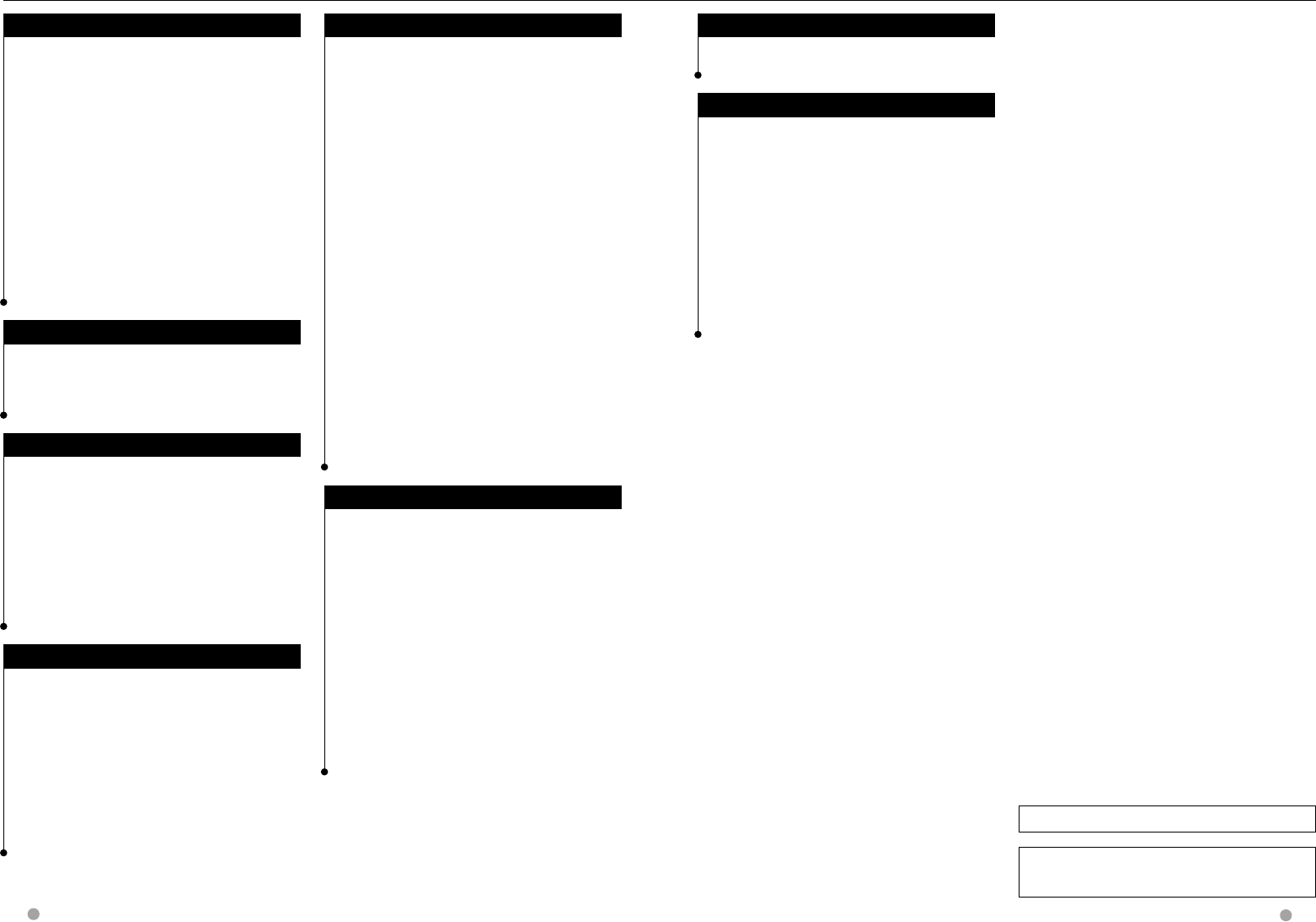
104 DNX9980HD English 105
DSP Section
DSP Section
Graphics equalizer
Band: 13 Band
Frequency (BAND1 – 13)
: 62.5/ 100/ 160/ 250/ 400/ 630/ 1k/ 1.6k/ 2.5k/ 4k/
6.3k/ 10k/ 16k Hz
Channel: Front/ Rear/ Center
Gain
: -9/ -8/ -7/ -6/ -5/ -4/ -3/ -2/ -1/ 0/ 1/ 2/ 3/ 4/ 5/ 6/ 7/
8/ 9 dB
X'over
High pass filter
Frequency: Through, 30/ 40/ 50/ 60/ 70/ 80/ 90/ 100/
120/ 150/ 180/ 220/ 250 Hz
Slope: -6/ -12/ -18/ -24 dB
Low pass filter
Frequency: 30/ 40/ 50/ 60/ 70/ 80/ 90/ 100/ 120/ 150/
180/ 220/ 250 Hz, Through
Slope: -6/ -12/ -18/ -24 dB
Time alignment
Front/ Rear/ Subwoofer
: 0 – 20.01 ft (0.07 ft Step)
Center: 0 – 11.15 ft (0.07 ft Step)
Position
: 0 – 5.68 ft (0.07 ft Step)
Channel Level
Front/ Rear/ Center : ± 10 dB
Subwoofer : -50 – +10 dB
Navigation section
Navigation section
Receiver
: High-sensitivity GPS receiver
Reception Frequency
: 1575.42 MHz (C/A code)
Acquisition Times
Cold : < 38 seconds
Factory Reset : < 45 seconds
(On average for a stationary receiver with a clear view
of the sky)
Accuracy
Position : < 10 meters typical
Velocity : 0.05 m/sec. RMS
Position Method
: GPS
Antenna
: External GPS antenna
FM tuner section
FM tuner section
Frequency Range (200 kHz space)
: 87.9 MHz – 107.9 MHz
Usable Sensitivity (S/N :30 dB)
: 9.3 dBf (0.8 μV/ 75 Ω)
Quieting Sensitivity (S/N :50 dB)
: 15.2 dBf (1.6 μV/ 75 Ω)
Frequency Response (± 3.0 dB)
Digital: 20 Hz – 20 kHz
Analog: 30 Hz – 15 kHz
S/N Ratio (dB)
Digital: 70 dB (STEREO)
Analog: 70 dB (MONO)
Selectivity (± 400 kHz)
: ≥ 80 dB
Stereo Separation
: 40 dB (1 kHz)
AM tuner section
AM tuner section
Frequency Range (10 kHz space)
: 530 kHz – 1700 kHz
Usable Sensitivity (S/N :20 dbB)
: 28 dBμ (25 μV)
Video section
Video section
Color System of External Video Input
: NTSC
External Video Input Level (mini jack)
: 1 Vp-p/ 75 Ω
External Audio Max Input Level (mini jack)
: 2 V/ 25 kΩ
Video Output Level (RCA jacks)
: 1 Vp-p/ 75 Ω
Audio Output Level (RCA jacks)
: 1.2 V/ 10 kΩ
Audio section
Audio section
Maximum Power (Front & Rear)
: 50 W x 4
Full Bandwidth Power (Front & Rear)
(4 Ω, 14.4 V, 1 % THD)
: 22 W x 4
Preout Level (V)
: 5 V/ 10 kΩ
Preout Impedance
: 80 Ω
Speaker Impedance
: 4 – 8 Ω
Specifications
External SW
External SW
Maximum Power Supply Current
: 500 mA
General
General
Operating voltage
: 14.4 V (10.5 – 16 V allowable)
Maximum Current Consumption
: 15 A
Dimensions (W × H × D)
: 181.7 × 100.0 × 180 mm
7-3/16 x 3-15/16 x 7-1/8 inch
Operational Temperature Range
: -10 °C – +60 °C
Storage Temperature Range
: -20 °C – +85 °C
Weight
: 2.54 kg (5.6 lbs)
Although the effective pixels for the liquid crystal panel is
given as 99.99% or more, 0.01% of pixels may not light or
may light incorrectly.
Specifications subject to change without notice.
DNX9980HD_K_English.indd 104-105 10/11/04 18:23
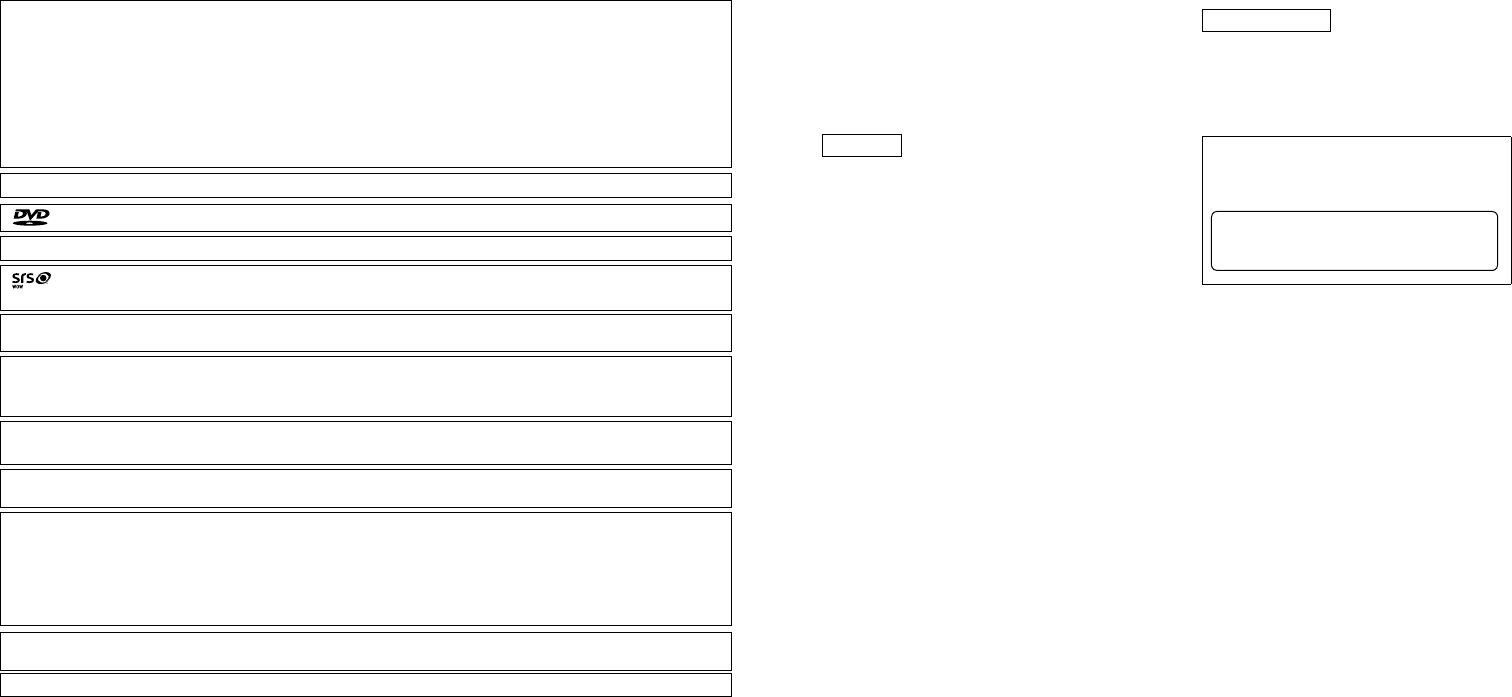
is a trademark of SRS Labs, Inc.
WOW technology is incorporated under license from SRS Labs, Inc.
is a trademark of DVD Format/Logo Licensing Corporation registered in the U.S., Japan and other countries.
This item incorporates copy protection technology that is protected by U.S. patents and other intellectual property rights of
Rovi Corporation. Reverse engineering and disassembly are prohibited.
Manufactured under license from Dolby Laboratories.
Dolby, Pro Logic and the double-D symbol are trademarks of Dolby Laboratories.
The "AAC" logo is a trademark of Dolby Laboratories.
The Bluetooth word mark and logos are owned by the Bluetooth SIG, Inc. and any use of such marks by Kenwood Corporation is
under license. Other trademarks and trade names are those of their respective owners.
HD Radio Technology manufactured under license from iBiquity Digital Corporation. U.S. and Foreign Patents. HD Radio™ and
the HD, HD Radio, and “Arc” logos are proprietary trademarks of iBiquity Digital Corp.
• “Adobe Reader” is a trademark of Adobe Systems Incorporated.
“Made for iPod” and “Made for iPhone” mean that an electronic accessory has been designed to connect specifically to iPod or
iPhone, respectively, and has been certified by the developer to meet Apple performance standards. Apple is not responsible
for the operation of this device or its compliance with safety and regulatory standards. Please note that the use of this
accessory with iPod or iPhone may affect wireless performance.
iPhone, iPod, iPod classic, iPod nano, and iPod touch are trademarks of Apple Inc., registered in the U.S. and other countries.
iTunes is a trademark of Apple Inc.
ABOUT DIVX VIDEO:
DivX® is a digital video format created by DivX, Inc. This is an official DivX Certified device that plays DivX video.
Visit www.divx.com for more information and software tools to convert your files into DivX video.
ABOUT DIVX VIDEO-ON-DEMAND:
This DivX Certified® device must be registered in order to play DivX Video-on-Demand (VOD) content. To
generate the registration code, locate the DivX VOD section in the device setup menu. Go to vod.divx.com with
this code to complete the registration process and learn more about DivX VOD.
DivX®, DivX Certified® and associated logos are registered trademarks of DivX, Inc. and are used under license.
Manufactured under license under U.S. Patent #’s: 5,451,942; 5,956,674; 5,974,380; 5,978,762; 6,487,535 & other U.S. and
worldwide patents issued & pending. DTS and the Symbol are registered trademarks & DTS Digital Surround and the DTS logos
are trademarks of DTS, Inc. Product includes software. © DTS, Inc. All Rights Reserved.
FCC WARNING
This equipment may generate or use radio frequency energy.
Changes or modifications to this equipment may cause
harmful interference unless the modifications are expressly
approved in the instruction manual. The user could lose the
authority to operate this equipment if an unauthorized change
or modification is made.
NOTE
This equipment has been tested and found to comply
with the limits for a Class B digital device, pursuant to Part
15 of the FCC Rules. These limits are designed to provide
reasonable protection against harmful interference in a
residential installation. This equipment may cause harmful
interference to radio communications, if it is not installed and
used in accordance with the instructions. However, there is
no guarantee that interference will not occur in a particular
installation. If this equipment does cause harmful interference
to radio or television reception, which can be determined by
turning the equipment off and on, the user is encouraged to
try to correct the interference by one or more of the following
measures:
• Reorient or relocate the receiving antenna.
• Increase the separation between the equipment and receiver.
• Connect the equipment into an outlet on a circuit different
from that to which the receiver is connected.
• Consult the dealer or an experienced radio/TV technician for
help.
IC (Industry Canada) Notice
Operation is subject to the following two conditions:
(1) This device may not cause interference, and
(2) this device must accept any interference, including
interference that may cause undesired operation of
the device.
The term "IC: " before the certification/registration
number only signifies that the Industry Canada
technical specification were met.
CALIFORNIA, USA ONLY
This product contains a CR Coin Cell Lithium Battery
which contains Perchlorate Material – special handling
may apply. See www.dtsc.ca.gov/hazardouswaste/
perchlorate
2CAUTION
Use of controls or adjustments or performance of procedures
other than those specified herein may result in hazardous
radiation exposure.
In compliance with Federal Regulations, following are
reproductions of labels on, or inside the product relating to
laser product safety.
Kenwood Corporation
2967-3, ISHIKAWA-MACHI,
HACHIOJI-SHI
TOKYO, JAPAN
KENWOOD CORP. CERTIFIES THIS EQUIPMENT
CONFORMS TO DHHS REGULATIONS N0.21 CFR
1040. 10, CHAPTER 1, SUBCHAPTER J.
Location : Top Panel
DNX9980HD_K_English.indd 106-107 10/11/04 18:23
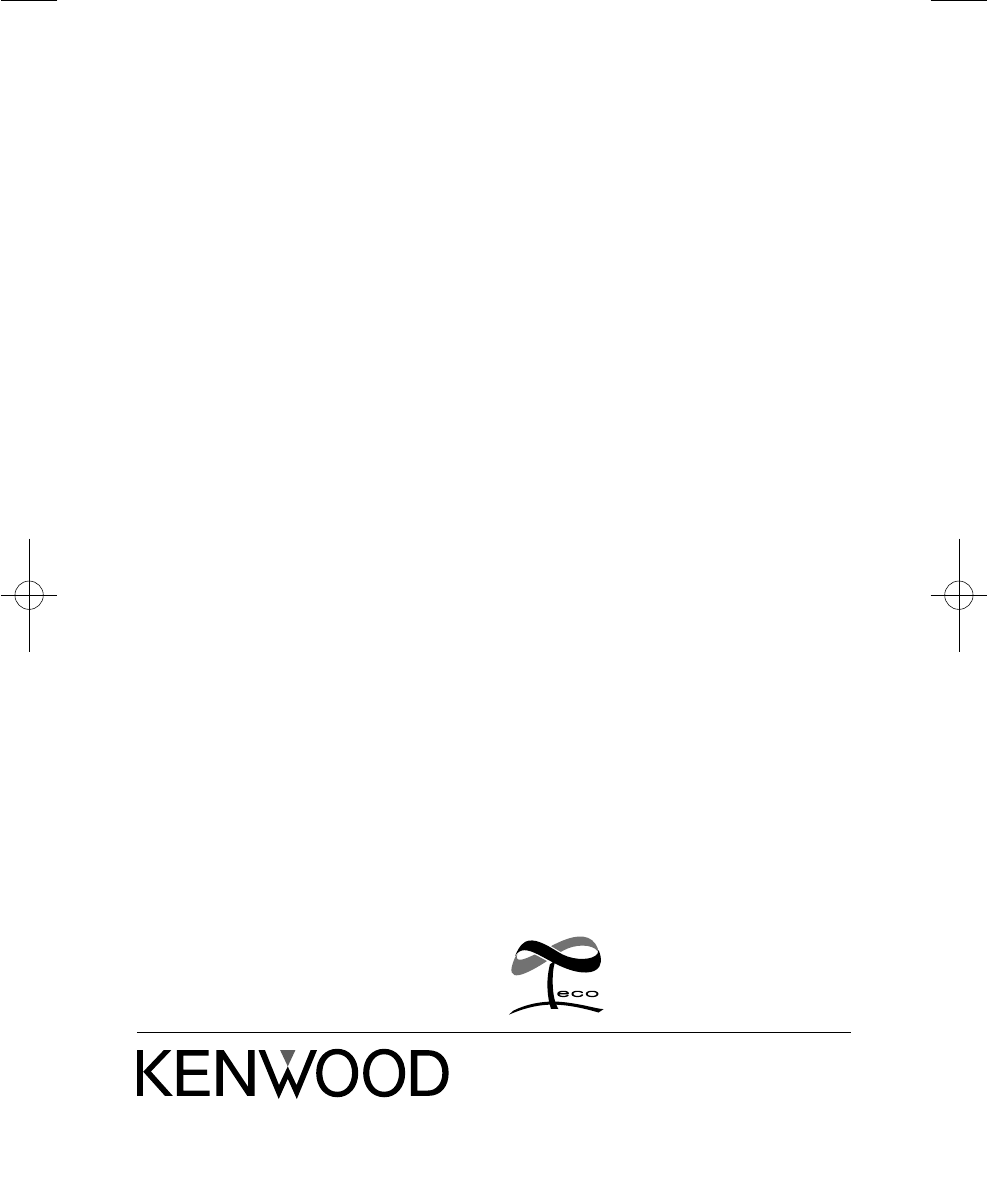
This symbol mark indicates that
Kenwood manufactured this
product so as to decrease harmful
infl uence on the environment.
DNX9980HD_K_English.indd 108 10/11/04 18:23